Vincent van Gogh
Vincent van Gogh was one of the world’s greatest artists, with paintings such as ‘Starry Night’ and ‘Sunflowers,’ though he was unknown until after his death.

(1853-1890)

Who Was Vincent van Gogh?
Vincent van Gogh was a post-Impressionist painter whose work — notable for its beauty, emotion and color — highly influenced 20th-century art. He struggled with mental illness and remained poor and virtually unknown throughout his life.
Early Life and Family
Van Gogh was born on March 30, 1853, in Groot-Zundert, Netherlands. Van Gogh’s father, Theodorus van Gogh, was an austere country minister, and his mother, Anna Cornelia Carbentus, was a moody artist whose love of nature, drawing and watercolors was transferred to her son.
Van Gogh was born exactly one year after his parents' first son, also named Vincent, was stillborn. At a young age — with his name and birthdate already etched on his dead brother's headstone — van Gogh was melancholy.
Theo van Gogh
The eldest of six living children, van Gogh had two younger brothers (Theo, who worked as an art dealer and supported his older brother’s art, and Cor) and three younger sisters (Anna, Elizabeth and Willemien).
Theo van Gogh would later play an important role in his older brother's life as a confidant, supporter and art dealer.
Early Life and Education
At age 15, van Gogh's family was struggling financially, and he was forced to leave school and go to work. He got a job at his Uncle Cornelis' art dealership, Goupil & Cie., a firm of art dealers in The Hague. By this time, van Gogh was fluent in French, German and English, as well as his native Dutch.
He also fell in love with his landlady's daughter, Eugenie Loyer. When she rejected his marriage proposal, van Gogh suffered a breakdown. He threw away all his books except for the Bible, and devoted his life to God. He became angry with people at work, telling customers not to buy the "worthless art," and was eventually fired.
Life as a Preacher
Van Gogh then taught in a Methodist boys' school, and also preached to the congregation. Although raised in a religious family, it wasn't until this time that he seriously began to consider devoting his life to the church
Hoping to become a minister, he prepared to take the entrance exam to the School of Theology in Amsterdam. After a year of studying diligently, he refused to take the Latin exams, calling Latin a "dead language" of poor people, and was subsequently denied entrance.
The same thing happened at the Church of Belgium: In the winter of 1878, van Gogh volunteered to move to an impoverished coal mine in the south of Belgium, a place where preachers were usually sent as punishment. He preached and ministered to the sick, and also drew pictures of the miners and their families, who called him "Christ of the Coal Mines."
The evangelical committees were not as pleased. They disagreed with van Gogh's lifestyle, which had begun to take on a tone of martyrdom. They refused to renew van Gogh's contract, and he was forced to find another occupation.
Finding Solace in Art
In the fall of 1880, van Gogh decided to move to Brussels and become an artist. Though he had no formal art training, his brother Theo offered to support van Gogh financially.
He began taking lessons on his own, studying books like Travaux des champs by Jean-François Millet and Cours de dessin by Charles Bargue.
Van Gogh's art helped him stay emotionally balanced. In 1885, he began work on what is considered to be his first masterpiece, "Potato Eaters." Theo, who by this time living in Paris, believed the painting would not be well-received in the French capital, where Impressionism had become the trend.
Nevertheless, van Gogh decided to move to Paris, and showed up at Theo's house uninvited. In March 1886, Theo welcomed his brother into his small apartment.
In Paris, van Gogh first saw Impressionist art, and he was inspired by the color and light. He began studying with Henri de Toulouse-Lautrec , Camille Pissarro and others.
To save money, he and his friends posed for each other instead of hiring models. Van Gogh was passionate, and he argued with other painters about their works, alienating those who became tired of his bickering.
DOWNLOAD BIOGRAPHY'S VINCENT VAN GOGH FACT CARD
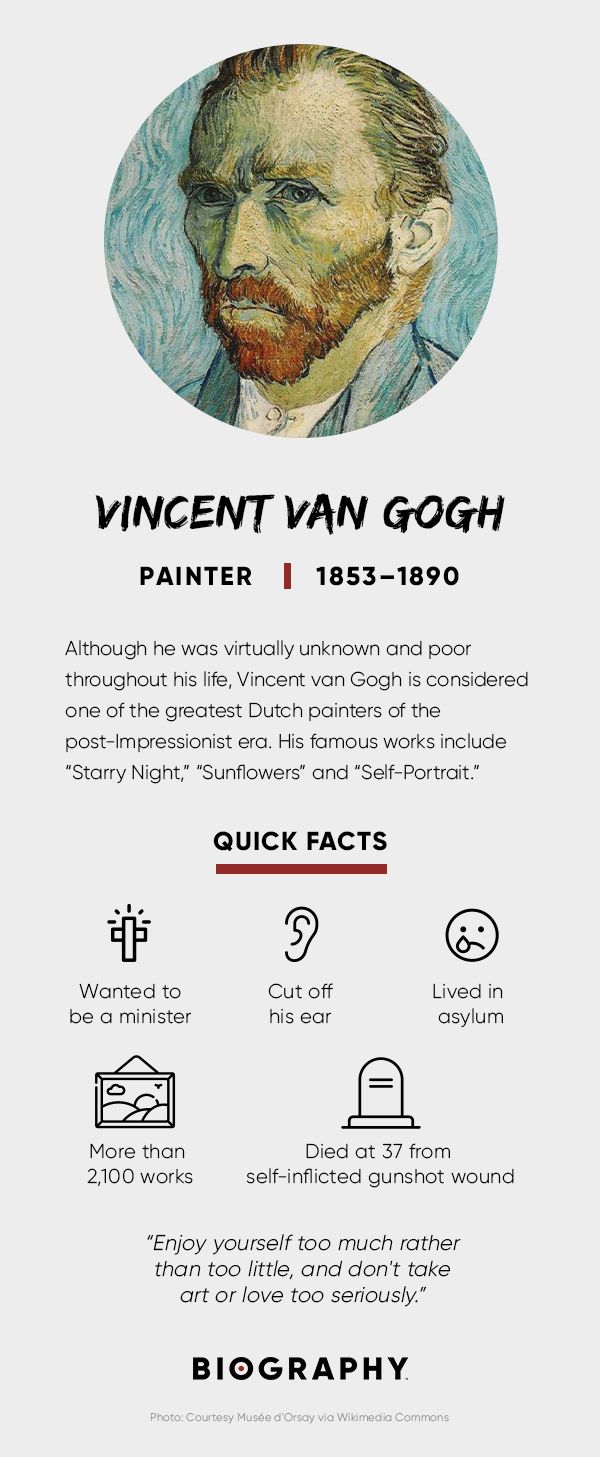
Van Gogh's love life was nothing short of disastrous: He was attracted to women in trouble, thinking he could help them. When he fell in love with his recently widowed cousin, Kate, she was repulsed and fled to her home in Amsterdam.
Van Gogh then moved to The Hague and fell in love with Clasina Maria Hoornik, an alcoholic prostitute. She became his companion, mistress and model.
When Hoornik went back to prostitution, van Gogh became utterly depressed. In 1882, his family threatened to cut off his money unless he left Hoornik and The Hague.
Van Gogh left in mid-September of that year to travel to Drenthe, a somewhat desolate district in the Netherlands. For the next six weeks, he lived a nomadic life, moving throughout the region while drawing and painting the landscape and its people.
Van Gogh became influenced by Japanese art and began studying Eastern philosophy to enhance his art and life. He dreamed of traveling there, but was told by Toulouse-Lautrec that the light in the village of Arles was just like the light in Japan.
In February 1888, van Gogh boarded a train to the south of France. He moved into a now-famous "yellow house" and spent his money on paint rather than food.
Vincent van Gogh completed more than 2,100 works, consisting of 860 oil paintings and more than 1,300 watercolors, drawings and sketches.
Several of his paintings now rank among the most expensive in the world; "Irises" sold for a record $53.9 million, and his "Portrait of Dr. Gachet" sold for $82.5 million. A few of van Gogh’s most well-known artworks include:
'Starry Night'
Van Gogh painted "The Starry Night" in the asylum where he was staying in Saint-Rémy, France, in 1889, the year before his death. “This morning I saw the countryside from my window a long time before sunrise, with nothing but the morning star, which looked very big,” he wrote to his brother Theo.
A combination of imagination, memory, emotion and observation, the oil painting on canvas depicts an expressive swirling night sky and a sleeping village, with a large flame-like cypress, thought to represent the bridge between life and death, looming in the foreground. The painting is currently housed at the Museum of Modern Art in New York, NY.
'Sunflowers'
Van Gogh painted two series of sunflowers in Arles, France: four between August and September 1888 and one in January 1889; the versions and replicas are debated among art historians.
The oil paintings on canvas, which depict wilting yellow sunflowers in a vase, are now displayed at museums in London, Amsterdam, Tokyo, Munich and Philadelphia.
In 1889, after entering an asylum in Saint-Rémy, France, van Gogh began painting Irises, working from the plants and flowers he found in the asylum's garden. Critics believe the painting was influenced by Japanese woodblock prints.
French critic Octave Mirbeau, the painting's first owner and an early supporter of Van Gogh, remarked, "How well he has understood the exquisite nature of flowers!"
'Self-Portrait'
Over the course of 10 years, van Gogh created more than 43 self-portraits as both paintings and drawings. "I am looking for a deeper likeness than that obtained by a photographer," he wrote to his sister.
"People say, and I am willing to believe it, that it is hard to know yourself. But it is not easy to paint yourself, either. The portraits painted by Rembrandt are more than a view of nature, they are more like a revelation,” he later wrote to his brother.
Van Gogh's self-portraits are now displayed in museums around the world, including in Washington, D.C., Paris, New York and Amsterdam.

Van Gogh's Ear
In December 1888, van Gogh was living on coffee, bread and absinthe in Arles, France, and he found himself feeling sick and strange.
Before long, it became apparent that in addition to suffering from physical illness, his psychological health was declining. Around this time, he is known to have sipped on turpentine and eaten paint.
His brother Theo was worried, and he offered Paul Gauguin money to go watch over Vincent in Arles. Within a month, van Gogh and Gauguin were arguing constantly, and one night, Gauguin walked out. Van Gogh followed him, and when Gauguin turned around, he saw van Gogh holding a razor in his hand.
Hours later, van Gogh went to the local brothel and paid for a prostitute named Rachel. With blood pouring from his hand, he offered her his ear, asking her to "keep this object carefully."
The police found van Gogh in his room the next morning, and admitted him to the Hôtel-Dieu hospital. Theo arrived on Christmas Day to see van Gogh, who was weak from blood loss and having violent seizures.
The doctors assured Theo that his brother would live and would be taken good care of, and on January 7, 1889, van Gogh was released from the hospital.
He remained, however, alone and depressed. For hope, he turned to painting and nature, but could not find peace and was hospitalized again. He would paint at the yellow house during the day and return to the hospital at night.
Van Gogh decided to move to the Saint-Paul-de-Mausole asylum in Saint-Rémy-de-Provence after the people of Arles signed a petition saying that he was dangerous.
On May 8, 1889, he began painting in the hospital gardens. In November 1889, he was invited to exhibit his paintings in Brussels. He sent six paintings, including "Irises" and "Starry Night."
On January 31, 1890, Theo and his wife, Johanna, gave birth to a boy and named him Vincent Willem van Gogh after Theo's brother. Around this time, Theo sold van Gogh's "The Red Vineyards" painting for 400 francs.
Also around this time, Dr. Paul Gachet, who lived in Auvers, about 20 miles north of Paris, agreed to take van Gogh as his patient. Van Gogh moved to Auvers and rented a room.
On July 27, 1890, Vincent van Gogh went out to paint in the morning carrying a loaded pistol and shot himself in the chest, but the bullet did not kill him. He was found bleeding in his room.
Van Gogh was distraught about his future because, in May of that year, his brother Theo had visited and spoke to him about needing to be stricter with his finances. Van Gogh took that to mean Theo was no longer interested in selling his art.
Van Gogh was taken to a nearby hospital and his doctors sent for Theo, who arrived to find his brother sitting up in bed and smoking a pipe. They spent the next couple of days talking together, and then van Gogh asked Theo to take him home.
On July 29, 1890, Vincent van Gogh died in the arms of his brother Theo. He was only 37 years old.
Theo, who was suffering from syphilis and weakened by his brother's death, died six months after his brother in a Dutch asylum. He was buried in Utrecht, but in 1914 Theo's wife, Johanna, who was a dedicated supporter of van Gogh's works, had Theo's body reburied in the Auvers cemetery next to Vincent.
Theo's wife Johanna then collected as many of van Gogh's paintings as she could, but discovered that many had been destroyed or lost, as van Gogh's own mother had thrown away crates full of his art.
On March 17, 1901, 71 of van Gogh's paintings were displayed at a show in Paris, and his fame grew enormously. His mother lived long enough to see her son hailed as an artistic genius. Today, Vincent van Gogh is considered one of the greatest artists in human history.
Van Gogh Museum
In 1973, the Van Gogh Museum opened its doors in Amsterdam to make the works of Vincent van Gogh accessible to the public. The museum houses more than 200 van Gogh paintings, 500 drawings and 750 written documents including letters to Vincent’s brother Theo. It features self-portraits, “The Potato Eaters,” “The Bedroom” and “Sunflowers.”
In September 2013, the museum discovered and unveiled a van Gogh painting of a landscape entitled "Sunset at Montmajour.” Before coming under the possession of the Van Gogh Museum, a Norwegian industrialist owned the painting and stored it away in his attic, having thought that it wasn't authentic.
The painting is believed to have been created by van Gogh in 1888 — around the same time that his artwork "Sunflowers" was made — just two years before his death.
Watch "Vincent Van Gogh: A Stroke of Genius" on HISTORY Vault

QUICK FACTS
- Name: Vincent van Gogh
- Birth Year: 1853
- Birth date: March 30, 1853
- Birth City: Zundert
- Birth Country: Netherlands
- Gender: Male
- Best Known For: Vincent van Gogh was one of the world’s greatest artists, with paintings such as ‘Starry Night’ and ‘Sunflowers,’ though he was unknown until after his death.
- Astrological Sign: Aries
- Brussels Academy
- Nacionalities
- Interesting Facts
- Some of van Gogh's most famous works include "Starry Night," "Irises," and "Sunflowers."
- In a moment of instability, Vincent Van Gogh cut off his ear and offered it to a prostitute.
- Van Gogh died in France at age 37 from a self-inflicted gunshot wound.
- Death Year: 1890
- Death date: July 29, 1890
- Death City: Auvers-sur-Oise
- Death Country: France
We strive for accuracy and fairness.If you see something that doesn't look right, contact us !
CITATION INFORMATION
- Article Title: Vincent van Gogh Biography
- Author: Biography.com Editors
- Website Name: The Biography.com website
- Url: https://www.biography.com/artists/vincent-van-gogh
- Access Date:
- Publisher: A&E; Television Networks
- Last Updated: March 4, 2020
- Original Published Date: April 3, 2014
- As for me, I am rather often uneasy in my mind, because I think that my life has not been calm enough; all those bitter disappointments, adversities, changes keep me from developing fully and naturally in my artistic career.
- I am a fanatic! I feel a power within me…a fire that I may not quench, but must keep ablaze.
- I get very cross when people tell me that it is dangerous to put out to sea. There is safety in the very heart of danger.
- I want to paint what I feel, and feel what I paint.
- As my work is, so am I.
- The love of art is the undoing of true love.
- When one has fire within oneself, one cannot keep bottling [it] up—better to burn than to burst. What is in will out.
- For my part I know nothing with any certainty, but the sight of the stars makes me dream.
- I do not say that my work is good, but it's the least bad that I can do. All the rest, relations with people, is very secondary, because I have no talent for that. I can't help it.
- What is wrought in sorrow lives for all time.
- What I draw, I see clearly. In these [drawings] I can talk with enthusiasm. I have found a voice.
- Enjoy yourself too much rather than too little, and don't take art or love too seriously.
- But I always think that the best way to know God is to love many things.
Famous Painters

11 Notable Artists from the Harlem Renaissance

Fernando Botero

Gustav Klimt

The Surreal Romance of Salvador and Gala Dalí

Salvador Dalí

Margaret Keane

Andy Warhol
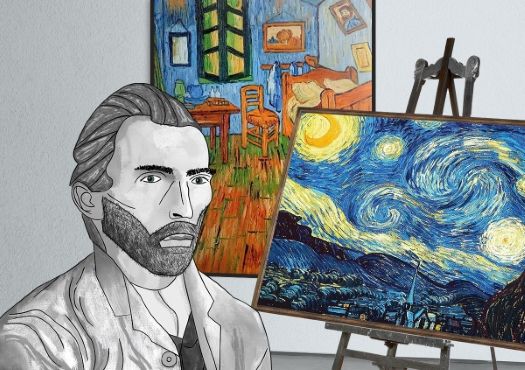
Vincent van Gogh
Dutch Draftsman and Painter

Summary of Vincent van Gogh
The iconic tortured artist, Vincent Van Gogh strove to convey his emotional and spiritual state in each of his artworks. Although he sold only one painting during his lifetime, Van Gogh is now one of the most popular artists of all time. His canvases with densely laden, visible brushstrokes rendered in a bright, opulent palette emphasize Van Gogh's personal expression brought to life in paint. Each painting provides a direct sense of how the artist viewed each scene, interpreted through his eyes, mind, and heart. This radically idiosyncratic, emotionally evocative style has continued to affect artists and movements throughout the 20 th century and up to the present day, guaranteeing Van Gogh's importance far into the future.
Accomplishments
- Van Gogh's dedication to articulating the inner spirituality of man and nature led to a fusion of style and content that resulted in dramatic, imaginative, rhythmic, and emotional canvases that convey far more than the mere appearance of the subject.
- Although the source of much upset during his life, Van Gogh's mental instability provided the frenzied source for the emotional renderings of his surroundings and imbued each image with a deeper psychological reflection and resonance.
- Van Gogh's unstable personal temperament became synonymous with the romantic image of the tortured artist. His self-destructive talent was echoed in the lives of many artists in the 20 th century.
- Van Gogh used an impulsive, gestural application of paint and symbolic colors to express subjective emotions. These methods and practice came to define many subsequent modern movements from Fauvism to Abstract Expressionism .
The Life of Vincent van Gogh
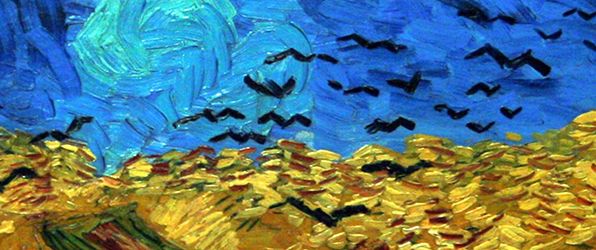
Vincent expressed his life via his works. As he famously said, "real painters do not paint things as they are... they paint them as they themselves feel them to be."
Important Art by Vincent van Gogh
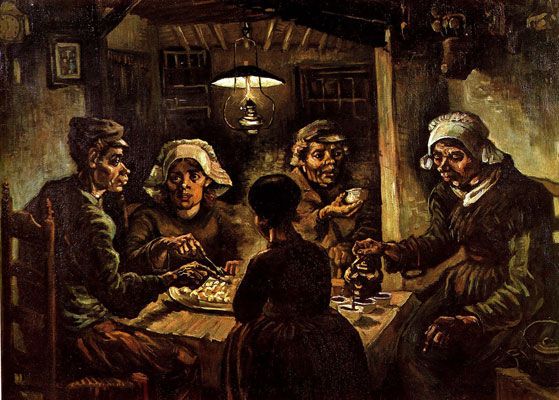
The Potato Eaters
This early canvas is considered Van Gogh's first masterpiece. Painted while living among the peasants and laborers in Nuenen in the Netherlands, Van Gogh strove to depict the people and their lives truthfully. Rendering the scene in a dull palette, he echoed the drab living conditions of the peasants and used ugly models to further iterate the effects manual labor had upon these workers. This effect is heightened by his use of loose brushstrokes to describe the faces and hands of the peasants as they huddle around the singular, small lantern, eating their meager meal of potatoes. Despite the evocative nature of the scene, the painting was not considered successful until after Van Gogh's death. At the time this work was painted, the Impressionists had dominated the Parisian avant-garde for over a decade with their light palettes. It is not surprising that Van Gogh's brother, Theo, found it impossible to sell paintings from this period in his brother's career. However, this work not only demonstrates Van Gogh's commitment to rendering emotionally and spiritually laden scenes in his art, but also established ideas that Van Gogh followed throughout his career.
Oil on canvas - The Van Gogh Museum, Amsterdam
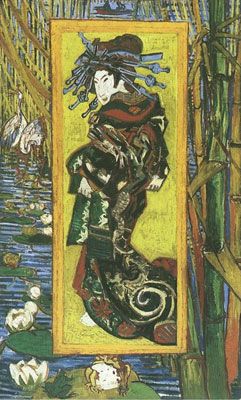
The Courtesan (after Eisen)
While in Paris, Van Gogh was exposed to a myriad of artistic styles, including the Japanese Ukiyo-e woodblock prints. These prints were only made available in the West in the mid-19 th century. Van Gogh collected works by Japanese ukiyo-e masters like Hiroshige and Hokusai and claimed these works were as important as works by European artists, like Rubens and Rembrandt. Van Gogh was inspired to create this particular painting by a reproduction of a print by Keisai Eisen that appeared on the May 1886 cover of the magazine Paris Illustré . Van Gogh enlarges Eisen's image of the courtesan, placing her in a contrasting, golden background bordered by a lush water garden based on the landscapes of other prints he owned. This particular garden is populated by frogs and cranes, both of which were allusions to prostitutes in French slang. While the stylistic features exhibited in this painting, in particular the strong, dark outlines and bright swaths of color, came to define Van Gogh's mature style, he also made the work his own. By working in paint rather than a woodblock print, Van Gogh was able to soften the work, relying on visible brushstrokes to lend dimension to the figure and her surroundings as well as creating a dynamic tension across the surface not present in the original prints.
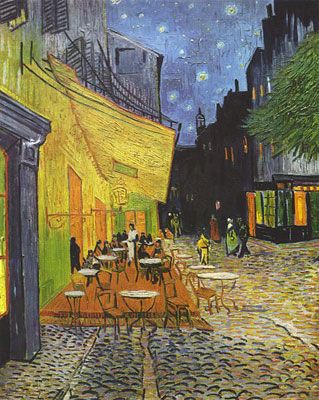
Café Terrace At Night
This was one of the scenes Van Gogh painted during his stay in Arles and a painting where he used his powerful nocturnal background. Using contrasting colors and tones, Van Gogh achieved a luminous surface that pulses with an interior light, almost in defiance of the darkening sky. The lines of composition all point to the center of the work drawing the eye along the pavement as if the viewer is strolling the cobblestone streets. The café still exists today and is a "mecca" for van Gogh fans visiting the south of France. Describing this painting in a letter to his sister he wrote, "Here you have a night painting without black, with nothing but beautiful blue and violet and green and in this surrounding the illuminated area colors itself sulfur pale yellow and citron green. It amuses me enormously to paint the night right on the spot..." Painted on the street at night, Van Gogh recreated the setting directly from his observations, a practice inherited from the Impressionists. However, unlike the Impressionists, he did not record the scene merely as his eye observed it, but imbued the image with a spiritual and psychological tone that echoed his individual and personal reaction. The brushstrokes vibrate with the sense of excitement and pleasure Van Gogh experienced while painting this work.
Oil on canvas - Kröller-Muller Museum, Otterlo
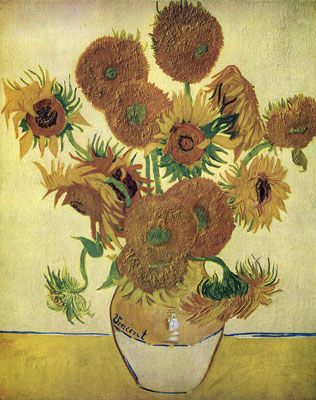
Van Gogh's Sunflower series was intended to decorate the room that was set aside for Gauguin at the "Yellow House," his studio and apartment in Arles. The lush brushstrokes built up the texture of the sunflowers and Van Gogh employed a wide spectrum of yellows to describe the blossoms, due in part to recently invented pigments that made new colors and tonal nuances possible. Van Gogh used the sunny hues to express the entire lifespan of the flowers, from the full bloom in bright yellow to the wilting and dying blossoms rendered in melancholy ochre. The traditional painting of a vase of flowers is given new life through Van Gogh's experimentation with line and texture, infusing each sunflower with the fleeting nature of life, the brightness of the Provencal summer sun, as well as the artist's mindset.
Oil on canvas - The National Gallery, London
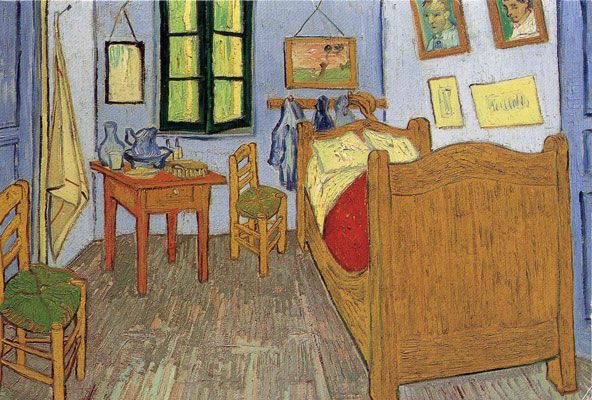
The Bedroom
Van Gogh's Bedroom depicts his living quarters at 2 Place Lamartine, Arles, known as the "Yellow House". It is one of his most well known images. His use of bold and vibrant colors to depict the off-kilter perspective of his room demonstrated his liberation from the muted palette and realistic renderings of the Dutch artistic tradition, as well as the pastels commonly used by the Impressionists. He labored over the subject matter, colors, and arrangements of this composition, writing many letters to Theo about it, "This time it's just simply my bedroom, only here color is to do everything, and giving by its simplification a grander style to things, is to be suggestive here of rest or of sleep in general. In a word, looking at the picture ought to rest the brain, or rather the imagination." While the bright yellows and blues might at first seem to echo a sense of disquiet, the bright hues call to mind a sunny summer day, evoking as sense of warmth and calm, as Van Gogh intended. This personal interpretation of a scene in which particular emotions and memories drive the composition and palette is a major contribution to modernist painting.
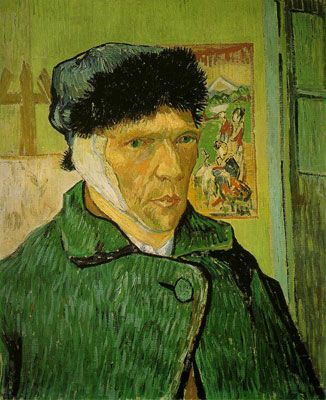
Self-Portrait with Bandaged Ear
After cutting off a portion of his left earlobe during a manic episode while in Arles, Van Gogh painted Self Portrait with a Bandaged Ear while recuperating and reflecting on his illness. He believed that the act of painting would help restore balance to his life, demonstrating the important role that artistic creation held for him. The painting bears witness to the artist's renewed strength and control in his art, as the composition is rendered with uncharacteristic realism, where all his facial features are clearly modeled and careful attention is given to contrasting textures of skin, cloth, and wood. The artist depicts himself in front of an easel with a canvas that is largely blank and a Japanese print hung on the wall. The loose and expressive brushstrokes typical of Van Gogh are clearly visible; the marks are both choppy and sinuous, at times becoming soft and diffuse, creating a tension between boundaries that are otherwise clearly marked. The strong outlines of his coat and hat mimic the linear quality of the Japanese print behind the artist. At the same time, Van Gogh deployed the technique of impasto, or the continual layering of wet paint, to develop a richly textured surface, which furthers the depth and emotive force of the canvas. This self-portrait, one of many Van Gogh created during his career, has an intensity unparalleled in its time, which is elucidated in the frank manner in which the artist portrays his self-inflicted wound as well as the evocative way he renders the scene. By combining influences as diverse as the loose brushwork of the Impressionists and the strong outlines from Japanese woodblock printing, Van Gogh arrived at a truly unique mode of expression in his paintings.
Oil on canvas - The Courtauld Gallery, London
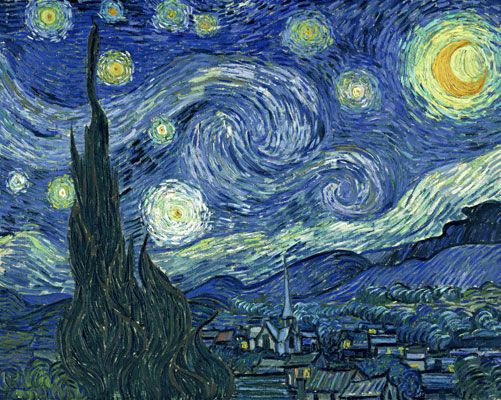
Starry Night
Starry Night is often considered to be Van Gogh's pinnacle achievement. Unlike most of his works, Starry Night was painted from memory, and not out in the landscape. The emphasis on interior, emotional life is clear in his swirling, tumultuous depiction of the sky - a radical departure from his previous, more naturalistic landscapes. Here, Van Gogh followed a strict principal of structure and composition in which the forms are distributed across the surface of the canvas in an exact order to create balance and tension amidst the swirling torsion of the cypress trees and the night sky. The result is a landscape rendered through curves and lines, its seeming chaos subverted by a rigorous formal arrangement. Evocative of the spirituality Van Gogh found in nature, Starry Night is famous for advancing the act of painting beyond the representation of the physical world.
Oil on canvas - The Museum of Modern Art, New York
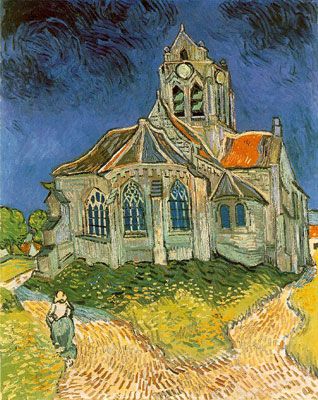
Church at Auvers
After Van Gogh left the asylum at Saint-Remy in May 1890 he travelled north to Auvers, outside of Paris. Church at Auvers is one of the most well-known images from the last few months of Van Gogh's life. Imbuing the landscape with movement and emotion, he rendered the scene with a palette of vividly contrasting colors and brushstrokes that lead the viewer through painting. Van Gogh distorted and flattened out the architecture of the church and depicted it caught within its own shadow - which reflects his own complex relationship to spirituality and religion. Van Gogh conveys a sense that true spirituality is found in nature, not in the buildings of man. The continued influence of Japanese woodblock printing is clear in the thick dark outlines and the flat swaths of color of the roofs and landscape, while the visible brushstrokes of the Impressionists are elongated and emphasized. The use of the acidic tones and the darkness of the church alludes to the impending mental disquiet that would eventually erupt within Van Gogh and lead to his suicide. This sense of instability plagued Van Gogh throughout his life, infusing his works with a unique blend of charm and tension.
Oil on canvas - Musée d'Orsay, Paris
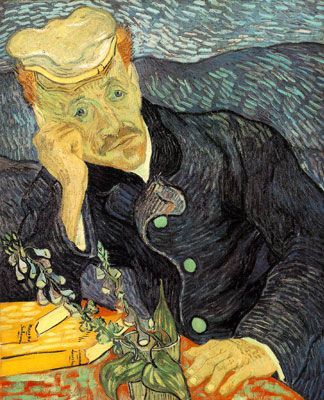
Paul-Ferdinand Gachet
Dr. Gachet was the homeopathic physician that treated Van Gogh after he was released from Saint-Remy. In the doctor, the artist found a personal connection, writing to his sister, "I have found a true friend in Dr. Gachet, something like another brother, so much do we resemble each other physically and also mentally." Van Gogh depicts Gachet seated at a red table, with two yellow books and foxglove in a vase near his elbow. The doctor gazes past the viewer, his eyes communicating a sense of inner sadness that reflects not only the doctor's state of mind, but Van Gogh's as well. Van Gogh focused the viewer's attention on the depiction of the doctor's expression by surrounding his face with the subtly varied blues of his jacket and the hills of the background. Van Gogh wrote to Gauguin that he desired to create a truly modern portrait, one that captured the "the heartbroken expression of our time." Rendering Gachet's expression through a blend of melancholy and gentility, Van Gogh created a portrait that has resonated with viewers since its creation. A recent owner, Ryoei Saito, even claimed he planned to have the painting cremated with him after his death, as he was so moved by the image. The intensity of emotion that Van Gogh poured into each brushstroke is what has made his work so compelling to viewers over the decades, inspiring countless artists and individuals.
Oil on canvas - Private Collection
Biography of Vincent van Gogh
Vincent Van Gogh was born the second of six children into a religious Dutch Reformed Church family in the south of the Netherlands. His father, Theodorus Van Gogh, was a clergyman and his mother, Anna Cornelia Carbentus, was the daughter of a bookseller. Van Gogh exhibited unstable moods during his childhood, and showed no early inclination toward art-making, though he excelled at languages while attending two boarding schools. In 1868, he abandoned his studies and never successfully returned to formal schooling.
Early Training
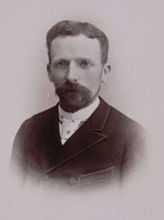
In 1869, Van Gogh apprenticed at the headquarters of the international art dealers Goupil & Cie in Paris and eventually worked at the Hague branch of the firm. He was relatively successful as an art dealer and stayed with the firm for almost a decade. In 1872, Van Gogh began exchanging letters with his younger brother Theo. This correspondence continued through the end of Vincent's life. The following year, Theo himself became an art dealer, and Vincent was transferred to the London office of Goupil & Cie. Around this time, Vincent became depressed and turned to God.
After several transfers between London and Paris, Van Gogh was let go from his position at Goupil's and decided to pursue a life in the clergy. While living in southern Belgium as a poor preacher, he gave away his possessions to the local coal-miners until the church dismissed him because of his overly enthusiastic commitment to his faith. In 1880, Van Gogh decided he could be an artist and still remain in God's service, writing, "To try to understand the real significance of what the great artists, the serious masters, tell us in their masterpieces, that leads to God; one man wrote or told it in a book; another, in a picture." Van Gogh was still a pauper, but Theo sent him some money for survival. Theo financially supported his elder brother his entire career, as Vincent made virtually no money from making art.
A year later, in 1881, dire poverty motivated Van Gogh to move back home with his parents, where he taught himself to draw. He became infatuated with his cousin, Kee Vos-Stricker. His continued pursuit of her affection, despite utter rejection, eventually split the family. With the support of Theo, Van Gogh moved to the Hague, rented a studio, and studied under Anton Mauve - a leading member of the Hague School. Mauve introduced Van Gogh to the work of the French painter Jean-François Millet , who was renowned for depicting common laborers and peasants.
In January 1882, while wandering the streets of The Hague, Van Gogh encountered a young prostitute (who also worked as a seamstress and housecleaner) by the name of Clasina Maria Hoornik. He soon came to refer to her as Christien, which he then shortened to, simply, Sien. She was destitute, addicted to alcohol, pregnant, and had her five year-old daughter Maria Wilhelmina, in tow. Van Gogh took pity on her, and took her into his care for the next year and a half. This dismayed his friends and family, and some of his patrons and benefactors, including his cousin-in-law Anton Mauve, and art dealer Hermanus Tersteeg, abruptly withdrew their support for him.
While Sien's account of their relationship portrays it as one merely of convenience and benevolence, it seems that Van Gogh felt more of a connection, and even had plans to marry her. In return for his support, Sien (as well as her children and mother) modeled for over fifty of Van Gogh's works, such as his 1882 drawing Sorrow , in which Sien appears pregnant, and which the artist once called "the best figure I've drawn". It seems, however, that what Van Gogh valued about her was the challenging life she had faced (she had during her life, become pregnant four different times by four different men, all of whom had abandoned her, and two of the children had died during infancy). He once referred to her as "pockmarked" and "no longer beautiful”, and often depicted her frowning, and in difficult or unflattering situations. Sien and her family also appeared in Van Gogh’s 1883 series The Public Soup Kitchen .
Mature Period
In 1884, after moving to Nuenen, Netherlands, Van Gogh began drawing the weathered hands, heads, and other anatomical features of workers and the poor, determined to become a painter of peasant life like Millet. Although he found a professional calling, his personal life was in shambles. Van Gogh accused Theo of not trying hard enough to sell his paintings, to which Theo replied that Vincent's dark palette was out of vogue compared to the bold and bright style of the Impressionist artists that was popular. Suddenly, on March 26, 1885, their father died from a stroke, putting pressure on Van Gogh to have a successful career. Shortly afterward, he completed the Potato Eaters (1885), his first large-scale composition and great work.
Leaving the Netherlands for the last time, in 1885 Van Gogh enrolled at the Academy of Fine Arts in Antwerp. There he discovered the art of Baroque painter Peter Paul Rubens , whose swirling forms and loose brushwork had a clear impact on the young artist's style. However, the rigidity of academicism of the school did not appeal to Van Gogh and he left for Paris the following year. He moved in with Theo in Montmartre - the artist's district in northern Paris - and studied with painter Fernand Cormon, who introduced the young artist to the Impressionists. The influence of artists such as Claude Monet , Camille Pissarro , Edgar Degas , and Georges Seurat , as well as pressure from Theo to sell paintings, motivated Van Gogh to adopt a lighter palette.
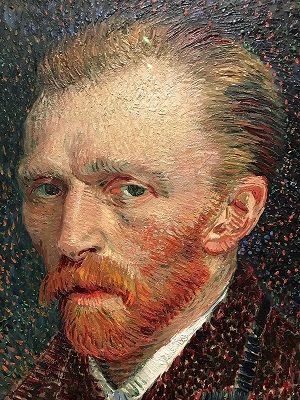
From 1886 to 1888, Van Gogh became acutely interested in Japanese prints and began to avidly study and collect them, even curating an exhibition of them at a Parisian restaurant. In late 1887, Van Gogh organized an exhibition that included his work and that of his colleagues Emile Bernard and Henri de Toulouse-Lautrec , and in early 1888, he exhibited with the Neo-impressionists Georges Seurat and Paul Signac at the Salle de Repetition of the Theatre Libre d'Antoine.
Late Years and Death
The majority of Van Gogh's best-known works were produced during the final two years of his life. During the fall and winter of 1888, Vincent Van Gogh and Paul Gauguin lived and worked together in Arles in the south of France, where Van Gogh eventually rented four rooms at 2 Place Lamartine, which was dubbed the "Yellow House" for its citron hue. The move to Provence began as a plan for a new artist's community in Arles as alternative to Paris and came at a critical point in each of the artists' careers. While at the "Yellow House" Gauguin and Van Gogh worked closely together and developed a concept of color symbolic of inner emotion and not dependent upon nature. Despite enormous productivity, Van Gogh suffered from various bouts of mental instability, likely including epilepsy, psychotic episodes, delusions, and bipolar disorder. Gauguin left for Tahiti, partially as a means of escaping Van Gogh's increasingly erratic behavior. The artist slipped away after a particularly violent fight in which Van Gogh threatened Gauguin with a razor and then cut off part of his own left ear.
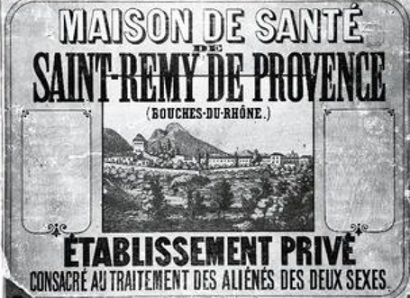
On May 8, 1889, reeling from his deteriorating mental condition, Van Gogh voluntarily committed himself into a psychiatric institution in Saint-Remy, near Arles. As the weeks passed, his mental well-being remained stable and he was allowed to resume painting. This period became one of his most productive. In the year spent at Saint-Remy, Van Gogh created over 100 works, including Starry Night (1889). The clinic and its garden became his main subjects, rendered in the dynamic brushstrokes and lush palettes typical of his mature period. On supervised walks, Van Gogh immersed himself in the experience of the natural surroundings, later recreating from memory the olive and cypress trees, irises, and other flora that populated the clinic's campus.
Shortly after leaving the clinic, Van Gogh moved north to Auvers-sur-Oise outside of Paris, to the care of a homeopathic doctor and amateur artist, Dr. Gachet. The doctor encouraged Van Gogh to paint as part of his recovery, and he happily obliged. He avidly documented his surroundings in Auvers, averaging roughly a painting a day over the last months of his life. However, after Theo disclosed his plan to go into business for himself and explained funds would be short for a while, Van Gogh's depression deepened sharply. On July 27, 1890, he wandered into a nearby wheat field and shot himself in the chest with a revolver. Although Van Gogh managed to struggle back to his room, his wounds were not treated properly and he died in bed two days later. Theo rushed to be at his brother's side during his last hours and reported that his final words were: "The sadness will last forever."
The Legacy of Vincent van Gogh
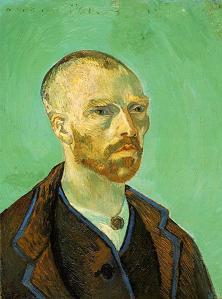
Clear examples of Van Gogh's wide influence can be seen throughout art history. The Fauves and the German Expressionists worked immediately after Van Gogh and adopted his subjective and spiritually inspired use of color. The Abstract Expressionists of the mid-20 th century made use of Van Gogh's technique of sweeping, expressive brushstrokes to indicate the artist's psychological and emotional state. Even the Neo-Expressionists of the 1980s, like Julian Schnabel and Eric Fischl , owe a debt to Van Gogh's expressive palette and brushwork. In popular culture, his life has inspired music and numerous films, including Vincente Minelli's Lust for Life (1956), which explores Van Gogh and Gauguin's volatile relationship. In his lifetime, Van Gogh created 900 paintings and made 1,100 drawings and sketches, but only sold one painting during his career. With no children of his own, most of Van Gogh's works were left to brother Theo.
Influences and Connections

Useful Resources on Vincent van Gogh

- Vincent Van Gogh: A Biography By Julius Meier-Graefe
- Stranger On The Earth: A Psychological Biography Of Vincent Van Gogh By Albert J. Lubin
- Vincent Van Gogh: Portrait of an Artist By Jan Greenberg, Sandra Jordan
- Dear Theo: The Autobiography of Vincent Van Gogh By Irving Stone, Jean Stone
- Letters of Vincent Van Gogh Our Pick By Vincent Van Gogh, Mark Roskill
- Van Gogh: The Complete Paintings Our Pick By Ingo F. Walther, Rainer Metzger
- Van Gogh in Provence and Auvers By Bogomila Welsh-Ovcharov
- Vincent's Colors By Vincent Van Gogh, The Metropolitan Museum of Art
- Vincent Van Gogh: The Drawings By Colta Ives, Susan Alyson Stein, Sjraar Van Heugten, Marije Vellekoop
- The Vincent Van Gogh Museum
- The Vincent Van Gogh Gallery Comprehensive image gallery of the artist's works
- Vincent Van Gogh: The Letters Our Pick Archives of Van Gogh's complete letters
- Van Gogh and the Colors of the Night Interactive website for the 2008 MoMA Exhibition
- Van Gogh's Ear and Modern Painting Our Pick By Adam Gopnik / The New Yorker / January 4, 2010
- Van Gogh's Night Visions By Paul Trachtman / Smithsonian Magazine / January 2009
- Nocturnal Van Gogh, Illuminating the Darkness Our Pick By Roberta Smith / The New York Times / September 18, 2008
- The Evolution of a Master Who Dreamed on Paper By Michael Kimmelman / The New York Times / October 14, 2005
- Where Van Gogh's Art Reached its Zenith By Grace Glueck / The New York Times / October 7, 1984
- Lust for Life Our Pick Book by Irving Stone
- Vincent & Theo Robert Altman's film about the brothers Van Gogh
- Don McLean's song 'Vincent (Starry Starry Night)'
Similar Art
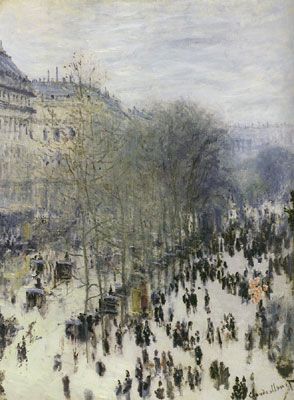
Boulevard des Capucines (1873)

Hoar Frost, the Old Road to Ennery, Pointoise (1873)
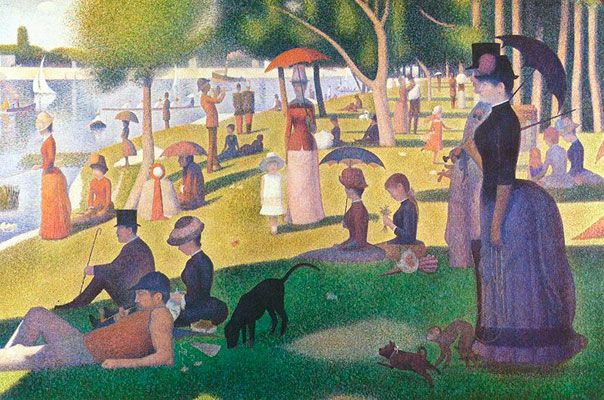
Sunday Afternoon on the Island of La Grand Jatte (1884-86)
Related artists.

Related Movements & Topics

Content compiled and written by The Art Story Contributors
Edited and published by The Art Story Contributors
Vincent van Gogh
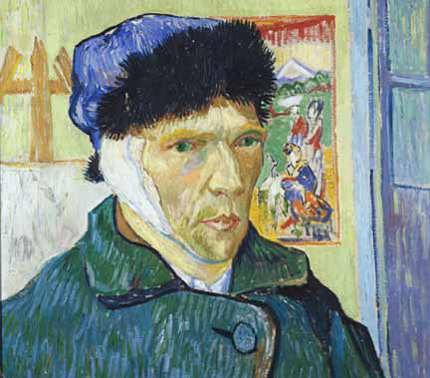
Van Gogh is today one of the most popular of the Post-Impressionist painters, although he was not widely appreciated during his lifetime. He is now famed for the great vitality of his works which are characterised by expressive and emotive use of brilliant colour and energetic application of impastoed paint. The traumas of his life, documented in his letters, have tended to dominate and distort modern perceptions of his art.
Van Gogh was born in Holland, the son of a pastor; he travelled to London in 1873, and first visited Paris in 1874. Over the next decade he was employed in various ways, including as a lay preacher. By 1883 he had started painting, and in 1885-6 he attended the academy in Antwerp where he was impressed by Japanese prints and by the work of Rubens . On his return to Paris in 1886 he met artists such as Degas , Gauguin and Seurat , and as a result lightened the colours he used. In 1888 Van Gogh settled in Arles in Provence, where he was visited by Gauguin and painted his now famous series of 'Sunflowers'. In the following year a nervous breakdown brought him to a sanatorium at St Remy; it was at this period that he executed 'A Wheatfield, with Cypresses' . In 1890, suffering from a new bout of depression, he shot himself in the chest and died two days later.
Paintings by Vincent van Gogh
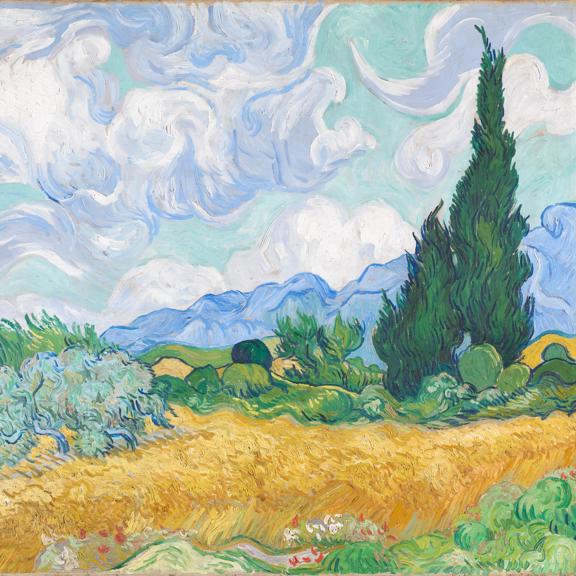
Why We Connect with Vincent van Gogh’s Paintings
Van Gogh was a troubled soul and master painter who relied on his emotions and color to create art that continues to attract millions of viewers.
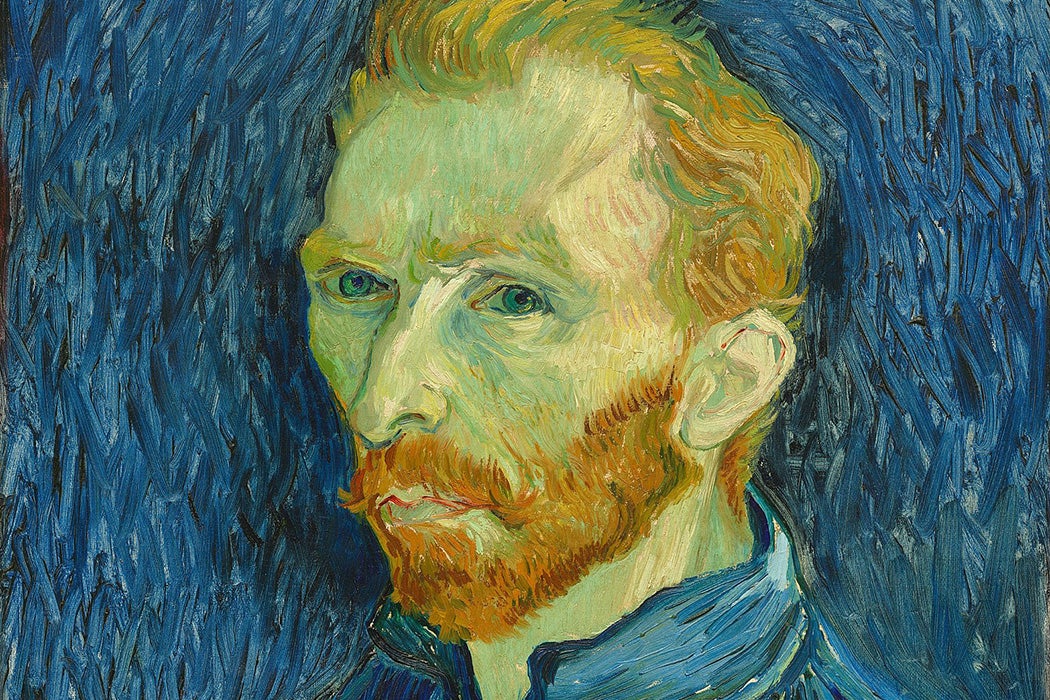
With the advent of digitization, art has become more accessible to the masses than ever before. While the world of NFTs and crypto art may not appeal to everyone, they can certainly engage with digitized versions of art with which they are already familiar. Dutch post-impressionist painter Vincent van Gogh’s work , with its distinctive use of color and unique methodology of form, lends itself particularly well to digitization.

Despite being one of the most renowned artists of the modern age, Van Gogh only received recognition after his 1890 death by suicide at age thirty-seven. In a 1962–63 paper published in the Bulletin of the Detroit Institute of the Arts , Professor of Art History at the University of Chicago, Joshua C Taylor, argues that Van Gogh’s work was based on his emotions and therefore resonates with viewers decades after his death . Taylor highlights Van Gogh’s “brief but intense career as a painter,” which made him adept at making a “painting that would project through its own sensuous form the emotion and vitality of a creative life.”
After a period of capturing the vagaries of the human condition through his dark and depressive portraits of peasant life, Van Gogh lived in Paris during the height of the Impressionist era . Hence, he “respond[ed] to the new color sensations with an intensity equal to that which he had first associated with religion, then with his awareness of the raw humanity of the wretchedly poor,” Taylor writes.
“I believe in the absolute necessity for a new art of color, of design and—of artistic life,” Van Gogh claimed. “And if we work in that faith, it seems to me there is a chance that our hope is not vain.”
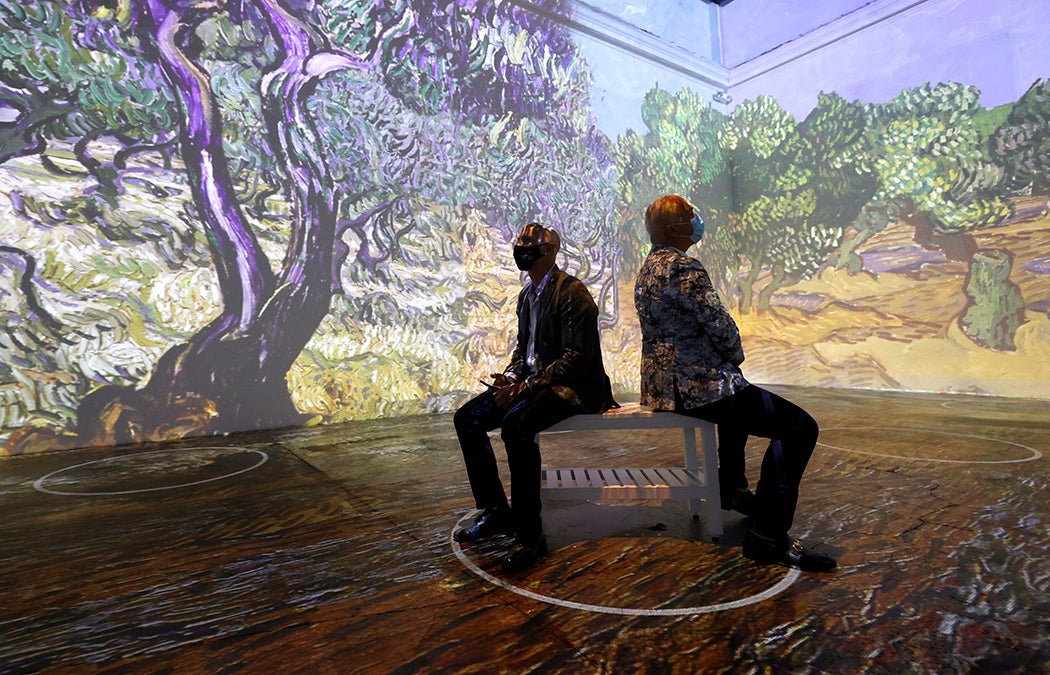
In his letters to his beloved brother Theo, Van Gogh wrote of being fascinated with the discovery of these colors:
I am always in the hope to express the love of two lovers by a marriage of two complementary colors, their mingling and their opposition, the mysterious vibrations of kindred tones. To express the thought of a brow by the radiance of a light tone against a sombre background.
Taylor argues that this new-found interest in vibrant color and form gave Van Gogh an insight into human values and the will to preserve them for posterity in a way that his previous exposure to religion and social work had not. As Vincent wrote to Theo,
[I]n a picture, I want to give something comforting as music is comforting. I want to paint men and women with that something of the eternal that the halo used to symbolize, and which we seek to give by the actual radiance and vibration of our colors.
It is this new and exciting quality that holds the viewer’s attention in Van Gogh’s work. As Taylor describes it, “Flowers burgeon with exhilarating energy, trees pulsate with life, and the world becomes live with a constantly renewing creative force.” He believes that Van Gogh’s presence in the paintings is inextricably linked with the viewer’s personal experience, and therefore Van Gogh’s self becomes an extension of the viewer.
Weekly Newsletter
Get your fix of JSTOR Daily’s best stories in your inbox each Thursday.
Privacy Policy Contact Us You may unsubscribe at any time by clicking on the provided link on any marketing message.
Perhaps the Van Gogh 360* Immersive Art experience has drawn crowds worldwide because of the artist’s emotive subjects , bold brush strokes, attractive colors, and the vibrant energy evident in his paintings. Taylor summarizes their appeal, describing Van Gogh’s paintings as a “special world he created for you in which there may be sadness and tragedy, but never loneliness.”
Support JSTOR Daily! Join our new membership program on Patreon today.

JSTOR is a digital library for scholars, researchers, and students. JSTOR Daily readers can access the original research behind our articles for free on JSTOR.
Get Our Newsletter
More stories.
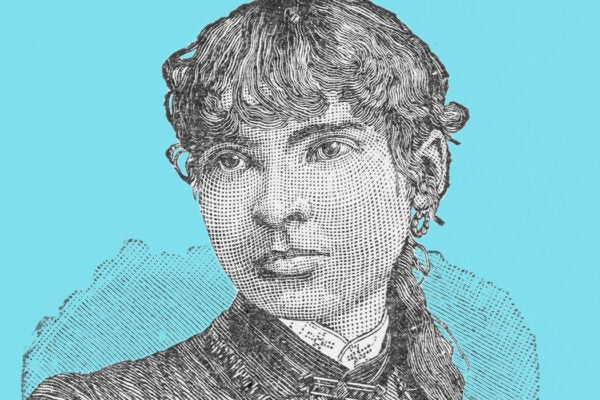
- Finding Lucretia Howe Newman Coleman

- The Novels that Taught Americans about Abortion

A “Genre-Bending” Poetic Journey through Modern Korean History

Arakawa and Gins: An Eternal Architecture
Recent posts.
- Palestinians against Fascism
- Dopamine, Hummus, and Iranian Politics
- Humans for Voyage Iron: The Remaking of West Africa
Support JSTOR Daily
Sign up for our weekly newsletter.
Visiting Sleeping Beauties: Reawakening Fashion?
You must join the virtual exhibition queue when you arrive. If capacity has been reached for the day, the queue will close early.
- The Collection
- The American Wing Ancient Near Eastern Art Arms and Armor The Michael C. Rockefeller Wing Asian Art The Cloisters The Costume Institute Drawings and Prints Egyptian Art European Paintings European Sculpture and Decorative Arts Greek and Roman Art Islamic Art Robert Lehman Collection The Libraries Medieval Art Musical Instruments Photographs Antonio Ratti Textile Center Modern and Contemporary Art
Crop your artwork:

Scan your QR code:
Gratefully built with ACNLPatternTool
Returned to lender The Met accepts temporary loans of art both for short-term exhibitions and for long-term display in its galleries.
The Starry Night
Vincent van Gogh Dutch
Not on view
Due to rights restrictions, this image cannot be enlarged, viewed at full screen, or downloaded.
Open Access
As part of the Met's Open Access policy , you can freely copy, modify and distribute this image, even for commercial purposes.
Public domain data for this object can also be accessed using the Met's Open Access API .
- https://www.metmuseum.org/art/collection/search/828514 https://www.metmuseum.org/art/collection/search/828514 Link copied to clipboard
- Animal Crossing
- Download image
- Enlarge image
Artwork Details
Use your arrow keys to navigate the tabs below, and your tab key to choose an item
Title: The Starry Night
Artist: Vincent van Gogh (Dutch, Zundert 1853–1890 Auvers-sur-Oise)
Date: June 1889
Medium: Oil on canvas
Dimensions: 29 × 36 1/4 in. (73.7 × 92.1 cm)
Classification: Paintings
Credit Line: The Museum of Modern Art, New York. Acquired through the Lillie P. Bliss Bequest (by exchange), 1941 Conservation was made possible by the Bank of America Art Conservation Project
Learn more about this artwork
Related artworks.
- All Related Artworks
- By Vincent van Gogh
- From Europe
- From Netherlands
- From A.D. 1800–1900
Lettres de Vincent van Gogh a Son Frère Théo
Road in Etten
At Eternity's Gate
Gardener by an Apple Tree
Burning Weeds
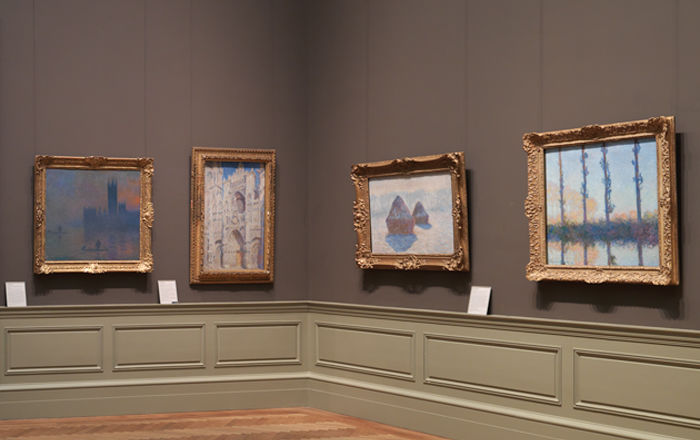
European Paintings at The Met

The various theories behind Vincent van Gogh's severed ear, plus more you may not know about his life
Posted: March 16, 2024 | Last updated: March 16, 2024

Vincent van Gogh: The life story you may not know
The life and works of Vincent van Gogh have enamored lovers of fine art since the late 20th century, many years after his tragic death in 1890 . His work in expressionism greatly influenced modern art , and his numerous letters and paintings have created a mythos around the late artist, with many considering him one of the greatest and most influential painters of all time.
Van Gogh produced some of the most notable and well-known paintings in the world, yet the Dutch painter lived a tormented life and never experienced the fame his work found after he died. Although living a life full of financial woes and a deteriorating mental state, Van Gogh still painted regularly to ease his mind, often with fervor. Plagued by mental illness and as a servant to his vices, Van Gogh's eccentricity and periods of insanity create a thrilling yet tragic story, of a man tortured by his demons and yet bestowed with an amazing gift curated meticulously over his decade as a painter.
Masterworks has rendered an intriguing portrait of the artist you may not know, including some of the most famously debated facts and speculations about the enigmatic painter.
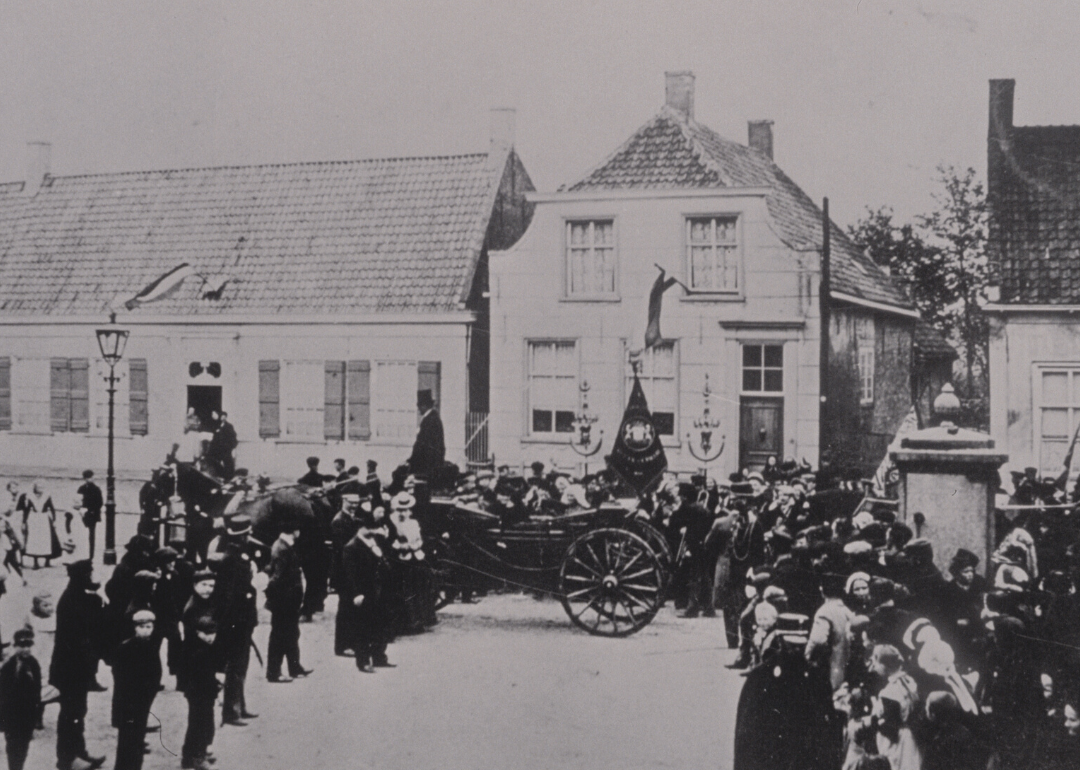
Van Gogh's nature-loving family
Vincent Willem van Gogh was born on March 30, 1853, in the Brabant village of Zundert, Netherlands, to Protestant minister Theodorus and Anna Carbentus van Gogh. His birth was followed by five siblings . The close-knit family would often venture around Zundert for walks, which helped instill an appreciation and love for nature in the young Van Gogh. His mother was also an amateur artist who encouraged her son to take up drawing and painting.
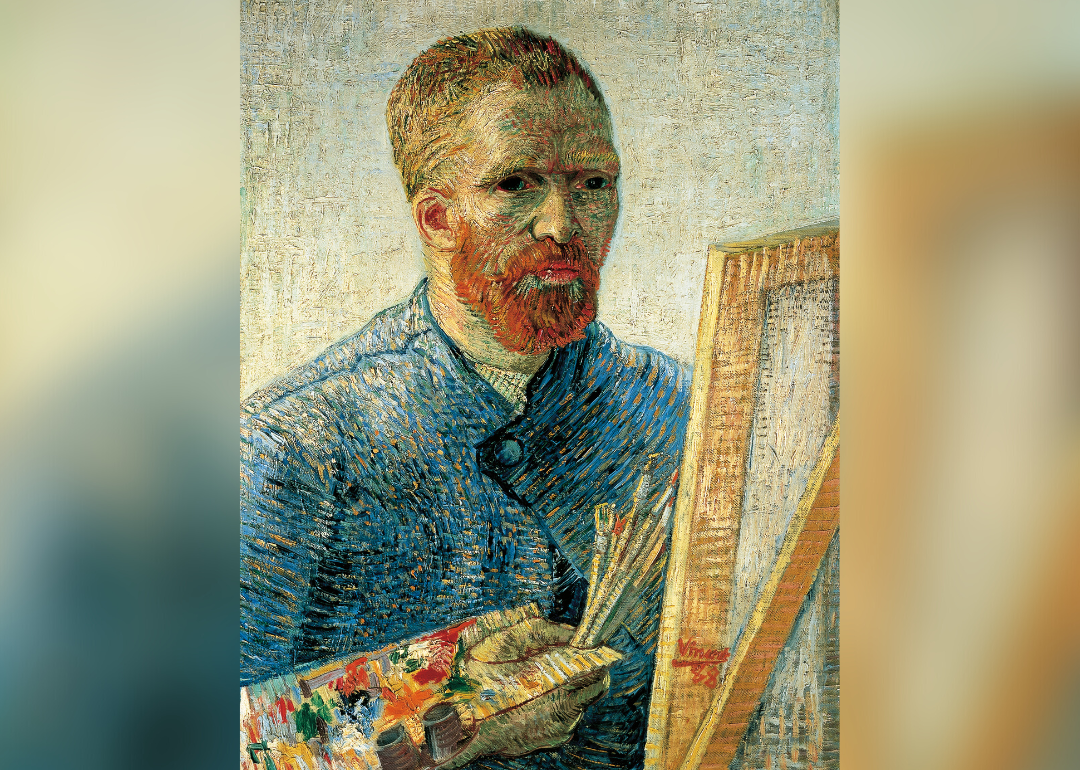
Named after his deceased brother
A year to the date before Vincent van Gogh was born, his mother gave birth to a stillborn child named Vincent Willem van Gogh after his paternal grandfather. Upon the artist Van Gogh's birth, he was given the same name as his deceased brother and even spent his childhood walking past a gravestone emblazoned with the full name they shared. According to historical records, there were four Vincent Willem van Goghs —the artist's deceased older brother, his grandfather, himself, and his brother Theo's son, born in 1890.
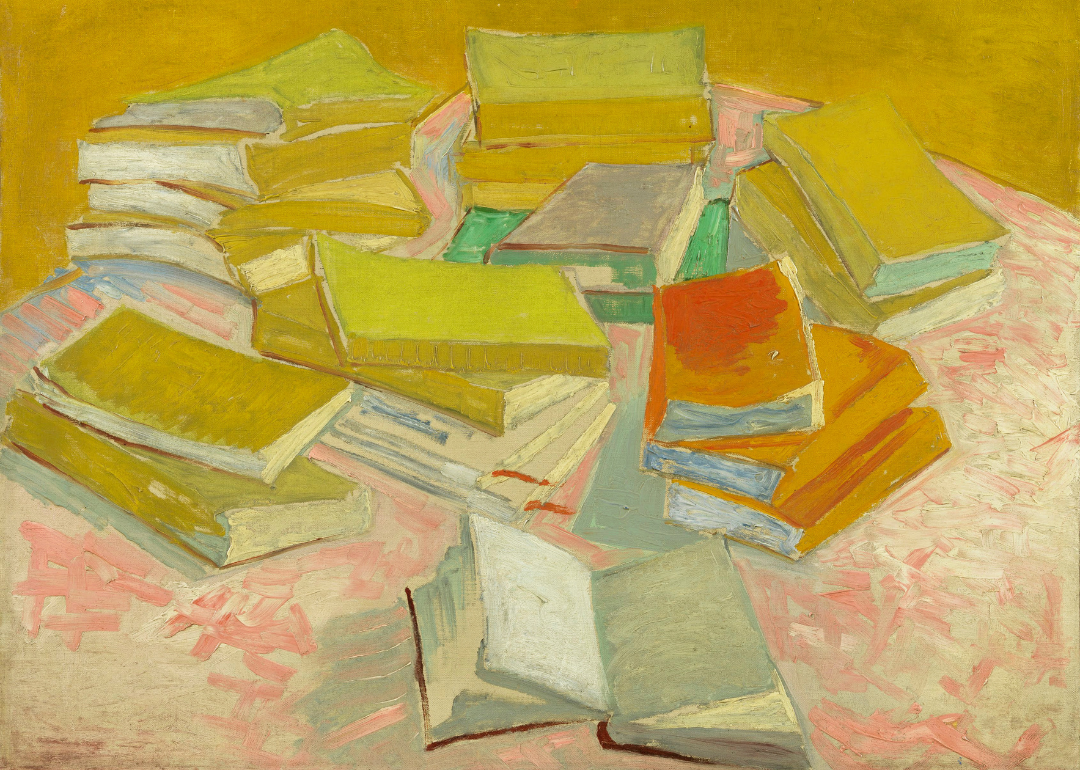
Left school at 15
When Van Gogh was 11 and had completed half of his elementary schooling, he was sent to a boarding school in Zevenbergen, about 15 miles from his home in Zundert, Netherlands. His time there was miserable, he missed his home, and although he would draw occasionally, he showed little artistic talent. In 1864, at 13, he entered King Willem II secondary school in Tilburg, Netherlands.
Van Gogh did well at the school, which offered art classes in addition to foreign languages, math, and sciences, but he left at 15 during his second year for reasons unknown, though his father's lack of funds to pay for schooling, a change in school personnel, an outbreak of disease, and even the beginnings of Van Gogh's mental illness have been considerable possibilities for his abrupt departure.
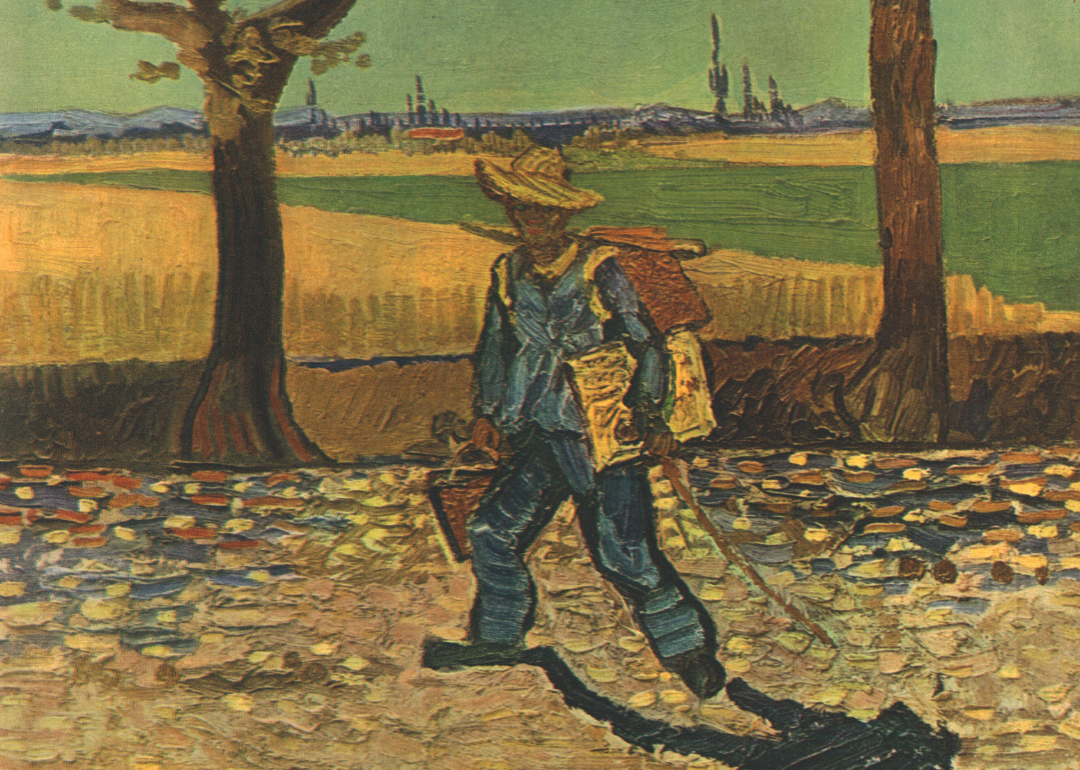
Worked as an art dealer
At 16, after leaving school and having nothing to keep him occupied, Van Gogh joined Goupil & Cie with the aid of his Uncle Cent, a partner at the firm who was also named Vincent. Goupil & Cie was known across Europe for its fine art collections and print dealers who'd worked in various branches worldwide. Van Gogh worked there for six years as an art dealer, first serving the firm in The Hague, Netherlands, then in London. He later joined Goupil's branch in Paris but was dismissed in 1876 due to his poor temperament.
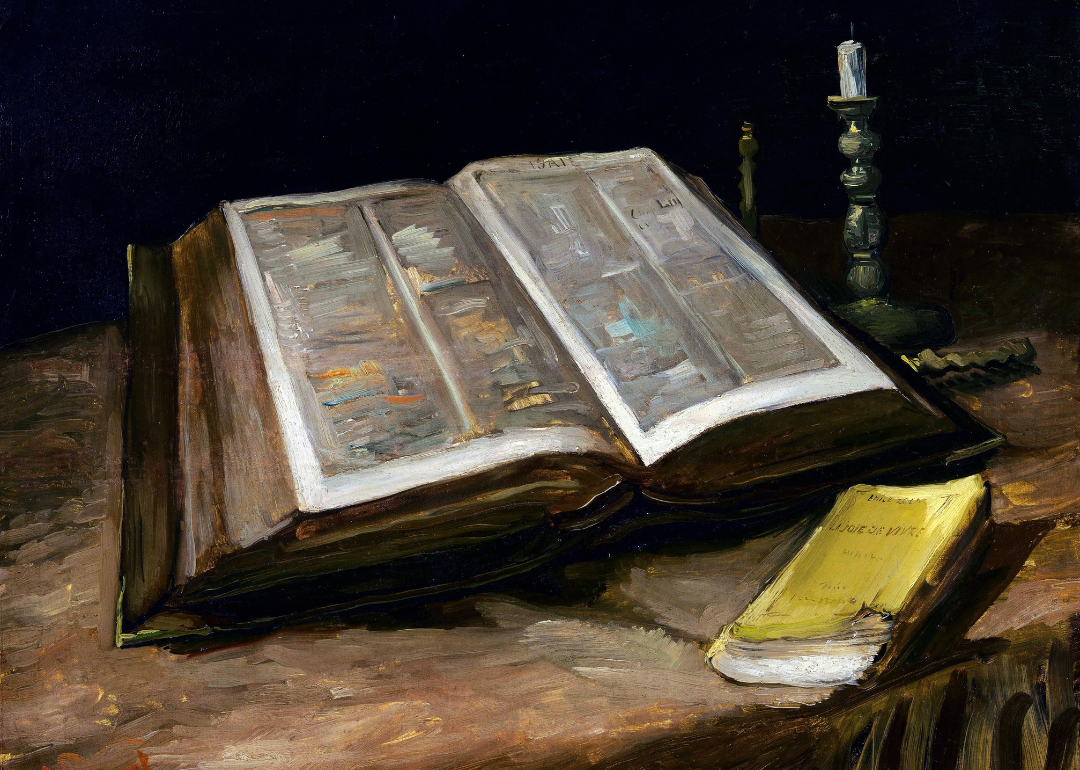
Varied careers before decade as a painter
After his dismissal as an art dealer from Goupil & Cie in 1876, Van Gogh's jobs seemed to come and go in short stints. He worked briefly as a teacher in Ramsgate, England, and was a book clerk in Dordrecht, Netherlands, in early 1877. At 25, he attempted following in his father's footsteps by becoming a pastor in a Belgian mining village but failed to connect with the miners despite valiant efforts. His time there did influence his future career, and his brother Theo suggested he pursue work as an artist during this time.

Influenced by Parisian painters to brighten his artwork
Van Gogh's early work , done when he worked among the Belgian miners, was full of dark colors and earth tones, illustrating peasants and moody landscapes influenced by the Dutch painting style at the time. Upon moving to Paris, he was prompted by Henri de Toulouse-Lautrec and Paul Gauguin to use colors with symbolic intention. He was directly influenced by artist Camille Pissarro, whose landscape paintings are full of intentional light and brightness. Van Gogh's palette became notably brighter during his time in Paris.
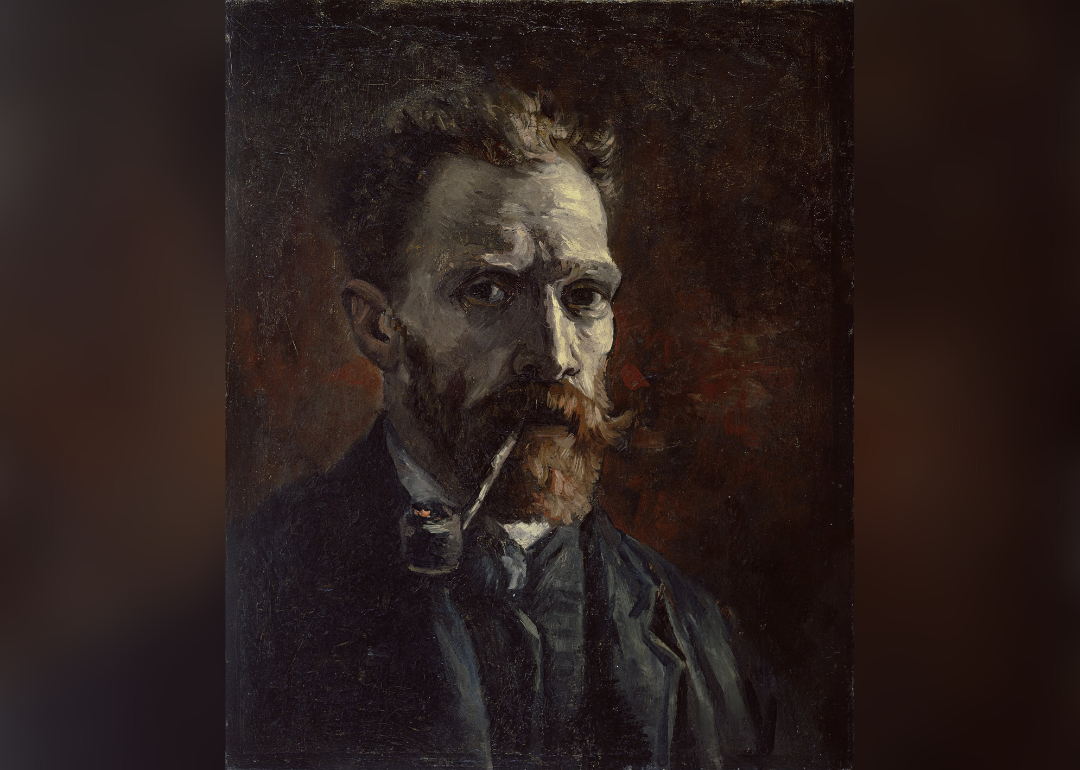
Self-portraits born from financial woes
It is estimated that in his 10 years as an artist, Van Gogh painted 36 self-portraits, his collection cementing him as one of the most prolific self-portraitists in art history. The majority of his self-portraits were done in Paris from 1886 to 1888, while he faced financial struggles that limited his practice of painting human subjects. Unable to afford models, Van Gogh often did studies of himself , helping to hone and develop his painting skills while also gleaning a somber side of the artist.

Possible genetic mental illness
Van Gogh struggled with mental illness throughout much of his life. Wilhemina "Wil" Jacoba van Gogh, his youngest sister, also lived with intense mental illness, spending the last 40 years of her life in a psychiatric facility until her death at 79 in 1941. Van Gogh and Wil were very close, and both shared a love of art. After he died in 1890, the family was able to pay for Wil's medical care with the 17 paintings he'd made for her.
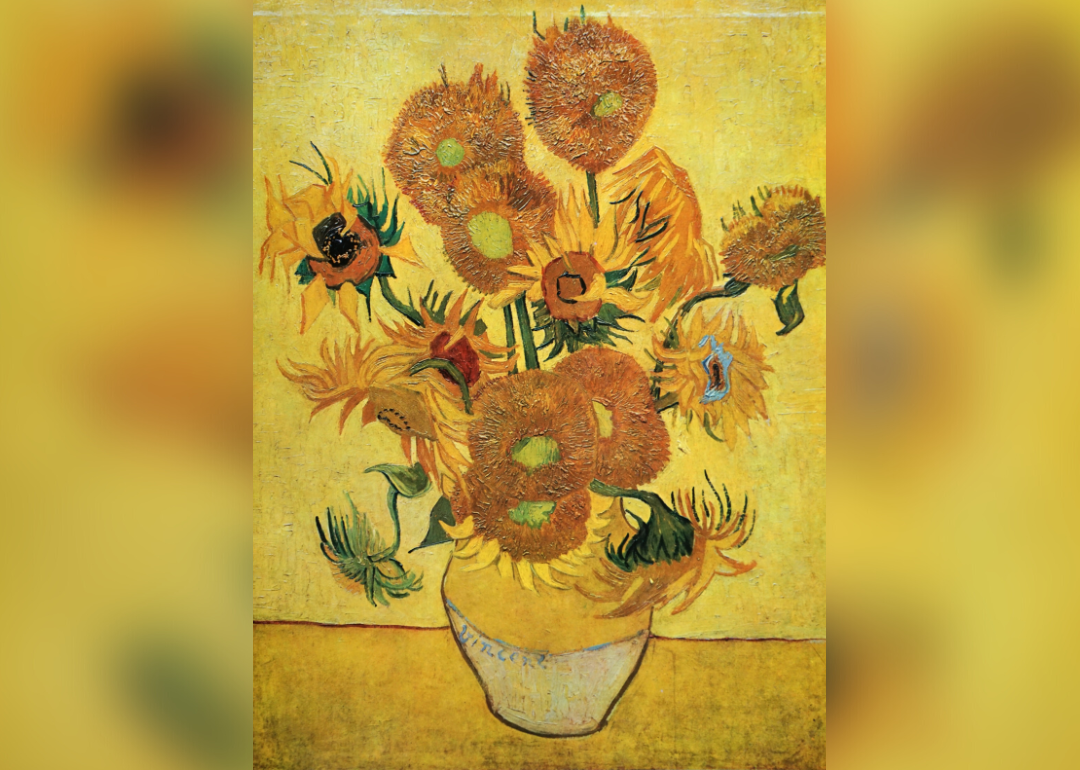
Love of nature inspires still-life sunflowers
Van Gogh produced 11 still-life paintings of sunflowers , one of his signature motifs. The sunflower's coarse features and lack of elegance created a stigma against the flower, although these were reasons Van Gogh fell in love with it.
The sunflowers he painted can be seen at different parts of their life cycle throughout the series. They often seemed more whimsical than real, which was attributed to his alleged mental illness, but it's been determined that in certain types of sunflowers, these really are genetic mutations . The color yellow was dominant in his paintings before 1889, as can also be seen in pieces such as " The Night Café " (1888) and " The Reaper " (1889).
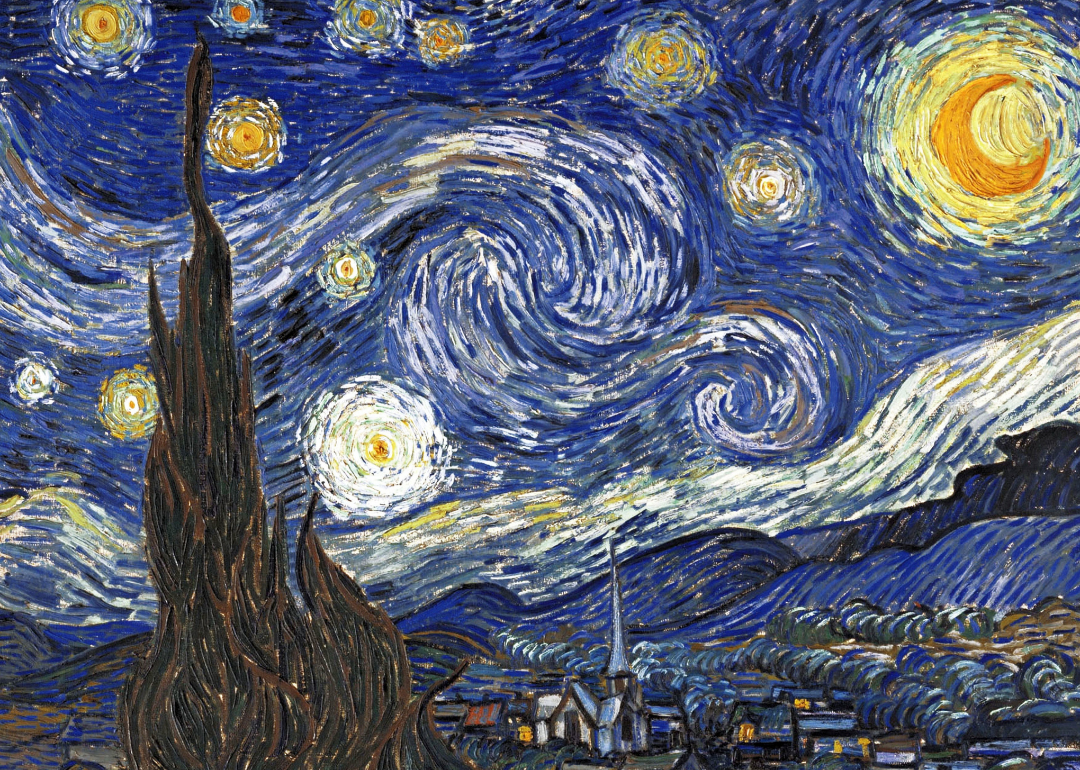
Creates best-known painting in an asylum
Possibly Van Gogh's most famous painting, "Starry Night," was created in 1889 at the Saint-Paul-de-Mausole asylum in France. In a bout of depression and experiences of hallucinations, his work exemplified a shift to darker colors. The view from his window in the asylum brought him inspiration, but as he was not allowed to paint in his room , he began painting it from memory and imagination in a studio provided to him by the asylum, creating the dreamlike piece that is now one of the most recognized paintings in the world. Upon its completion, Van Gogh considered the work a failure.
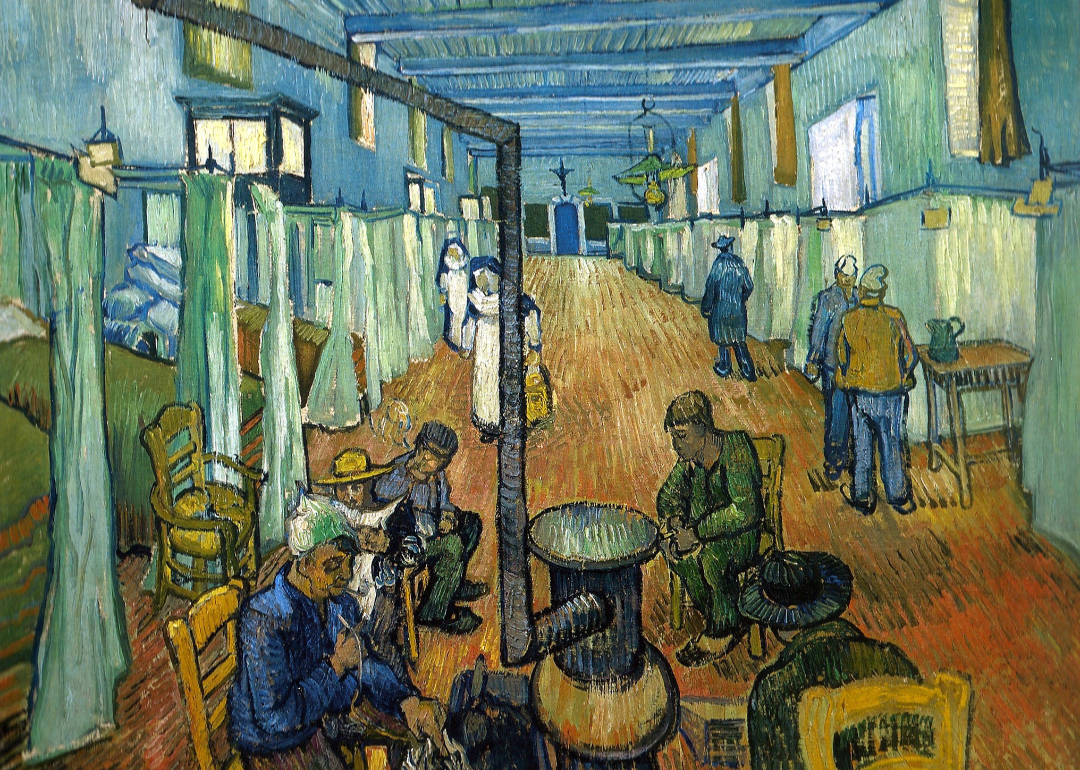
Debate on Van Gogh's medical history continues
Van Gogh's medical history has been a hotly debated topic despite little evidence to point to a proper diagnosis. More than 150 physicians have attempted various diagnoses, although very little is confirmed, according to the American Journal of Psychiatry . Mental illness, paired with excessive alcohol consumption, and the use of absinthe and other toxins make a proper diagnosis near impossible.
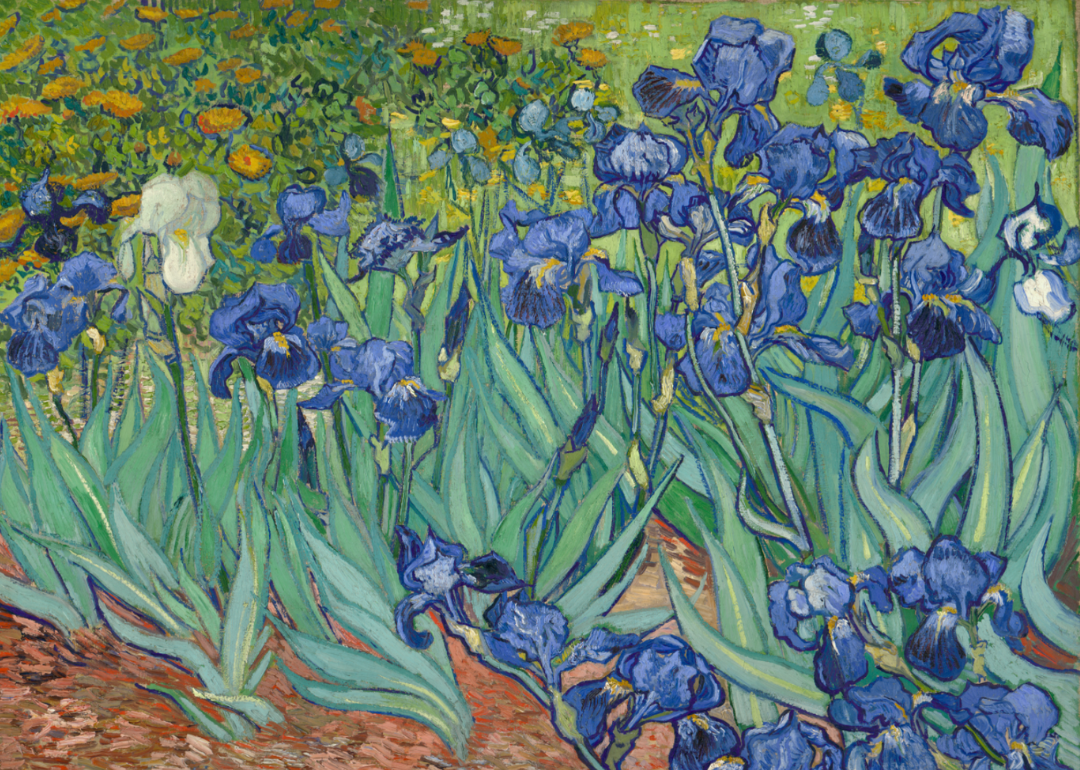
Nearly 2,000 works of art deem Van Gogh incredibly prolific
To master painting, Van Gogh strongly believed that one must master drawing first. He produced more than 1,100 drawings and often sketched drawings as a part of his process before creating new paintings.
Van Gogh began painting seriously in 1881 at 28, a practice that brought him great joy, according to letters written to his brother Theo, considering it the start of his true career. In addition to his drawings, Van Gogh created a staggering amount of beautiful work at a rapid pace, producing about 900 oil paintings during his 10-year art career.

Exhausting time in Paris greatly influences work
Van Gogh went to Paris in 1886, where he shared an apartment with Theo, his younger brother, who supported him financially . The impressionist painting style and the city life of northern Paris highly influenced Van Gogh's work. His paintings during this time depicted much of the gorgeous architecture and rural scenery . He also found great inspiration in Japanese prints , which further removed him from his background in Dutch-style painting. While Van Gogh's time in Paris was highly influential, it was physically taxing on the artist.

Move to southern France ends with time in an asylum
In February 1888, Van Gogh moved to Arles , in southern France, to enjoy the country life, to sever his financial dependence on his brother Theo, and possibly set up a colony with other artists. His work gravitated toward using simplified colors and light that seemed to radiate its own warmth without casting shadows. One of his most notable paintings, "The Night Café," was painted in September of that year.
Although Van Gogh experienced good health at the beginning of his time in the country, he began experiencing seizures and fainting. The townspeople also turned against him, and during the end of a two-month visit from his friend Paul Gauguin that started in October 1888, Van Gogh famously severed his left ear. After this incident, he admitted himself to a mental asylum.
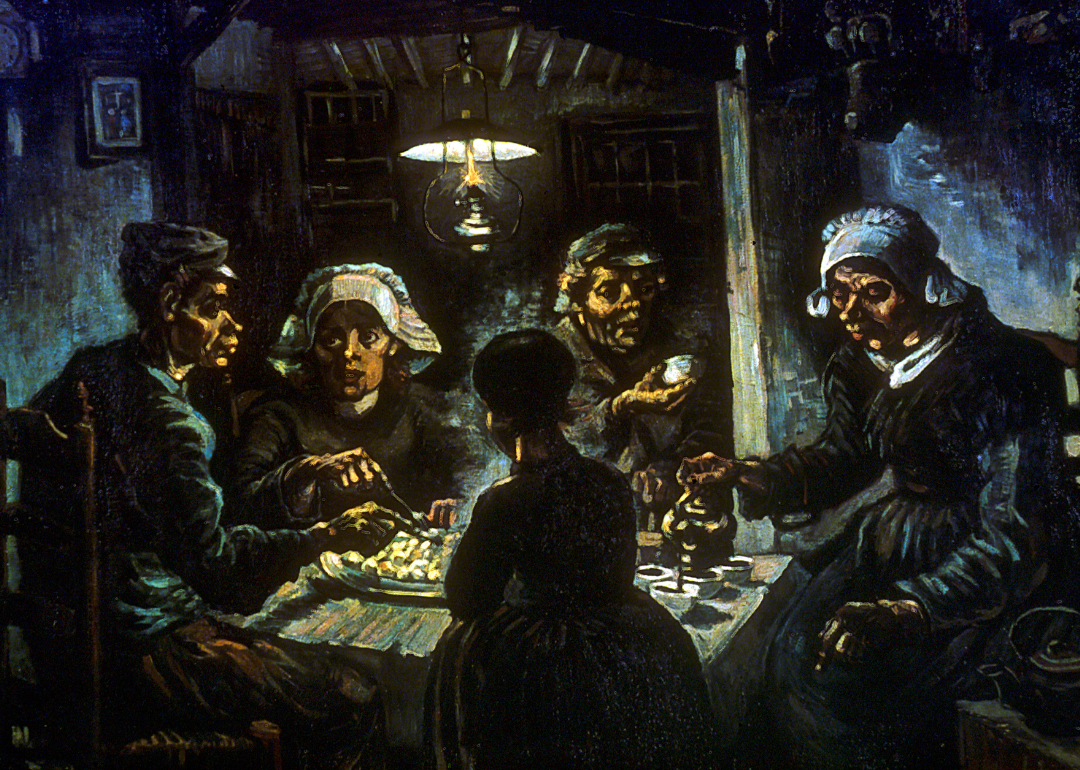
Formation of the art world's most well-known post-impressionists
Van Gogh developed friendships with artists who were often tumultuous or wrought with conflict. During Van Gogh's Dutch painting period, fellow artist Anthon van Rappard criticized " The Potato Eaters " (1885), considered one of Van Gogh's first masterpieces. This infuriated Van Gogh; however, the two artists did stay in touch through letters, giving fresh criticism of each other's work during their five years of friendship.
While studying art in Paris, Van Gogh was under the tutelage of artist Fernand Cormon and met Émile Bernard and Paul Gauguin during his time there. Van Gogh looked up to Gauguin, though their relationship would become fraught. Theo van Gogh also introduced his older brother to such avant garde artists as Henri de Toulouse-Lautrec, Paul Cézanne, and Georges Seurat. Including Van Gogh, the group became known as the post-impressionists .
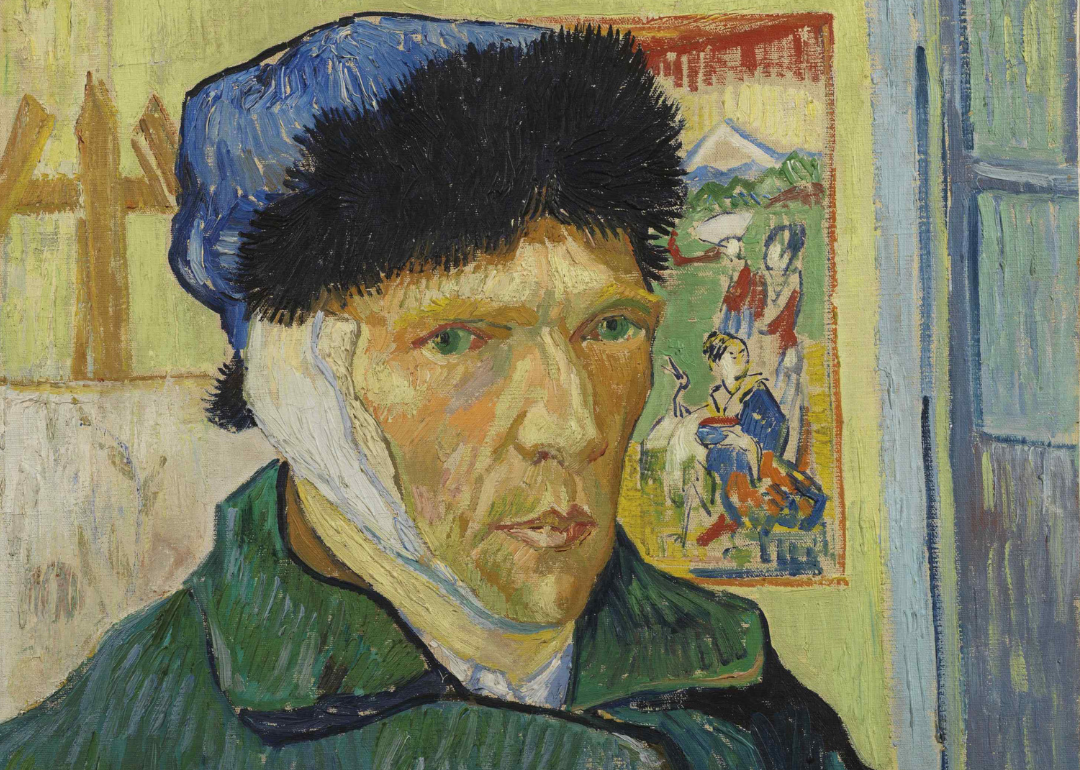
Seriousness of Van Gogh's ear severing clarified
The buzzing speculation around the truth and lies of Van Gogh's severed left ear has baffled historians for decades. What is known for sure is that on Dec. 23, 1888, Van Gogh was in the midst of a terrible mental breakdown that resulted in him severing his left ear.
In 1930, Dr. Félix Rey, who originally treated Van Gogh for the injury, wrote and illustrated a note detailing the severment , calling into question historian conclusions that only the lobe had been severed.
Art historian Bernadette Murphy's research into census records and tracking family history gleaned that the ear may have been given to a cleaner named Rachel who'd worked at a brothel Van Gogh had frequented.
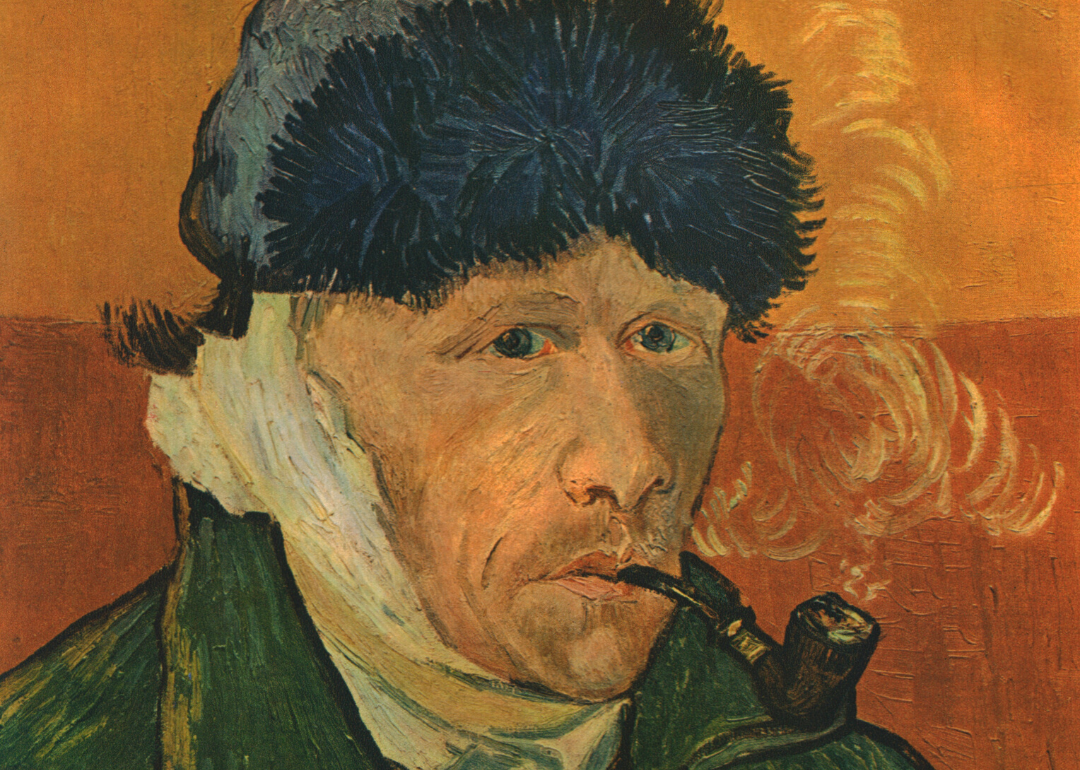
Another take: Speculation that Paul Gauguin cut off Van Gogh's ear
While the Van Gogh Museum in the Netherlands stands by the narrative that Van Gogh cut off his own ear, German art historians Hans Kaufmann and Rita Wildegans have cited inconsistencies in Paul Gauguin's story, hinting at a more complex truth as reason to reconsider the storyline.
After 10 years of research into letters, witness accounts, and police records, the two historians argue that fencing aficionado Gauguin severed Van Gogh's ear in their famous brawl in 1888. They theorize that Gauguin may have acted in self-defense due to Van Gogh's aggressive nature and declining mental health. However, their evidence is weak, and there is no smoking gun to prove that any of this theory is more than hearsay.
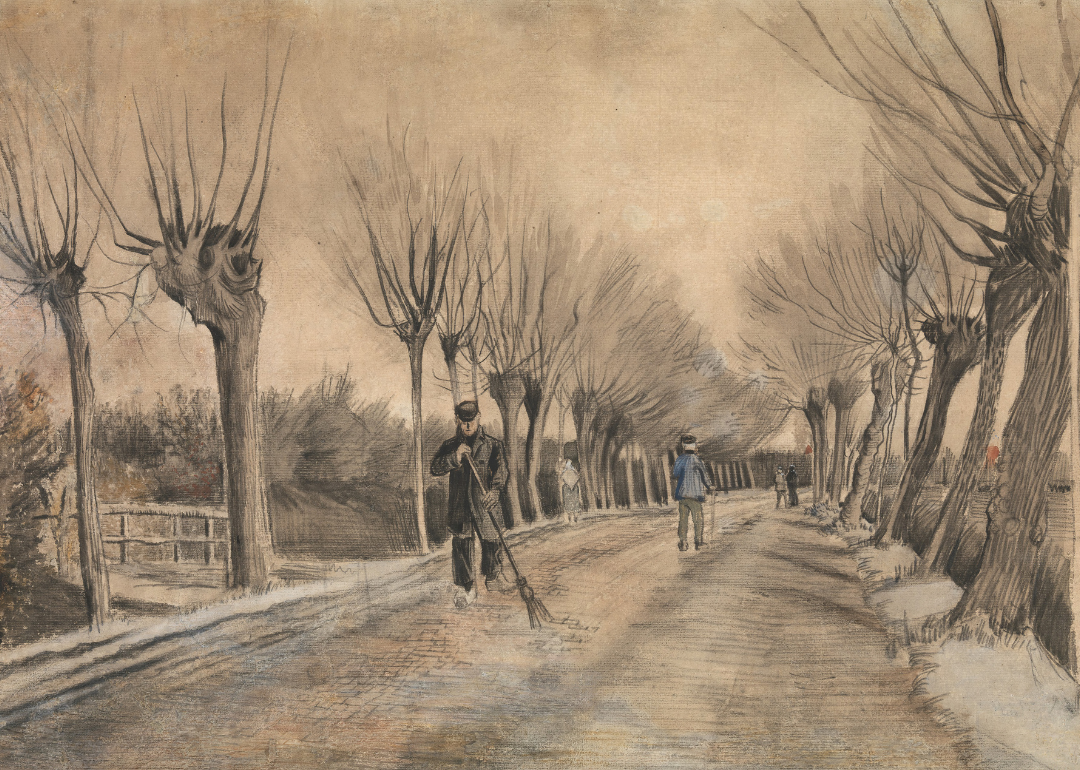
Self-taught despite dabbling in art school
The artist Van Gogh was largely self-taught and received criticism for his unique style while in art school. At 27, when beginning his career, he studied at an artists academy in Brussels under the tutelage of Anthon van Rappard for nine months.
When Van Gogh moved to The Hague, Netherlands, in 1881, he again joined an artists academy and took classes from his cousin by marriage, Anton Mauve, before they had a falling out. While these short stints in art school may have drawn some inspiration for Van Gogh, the best strides in his work were pushed by his personal experiences.
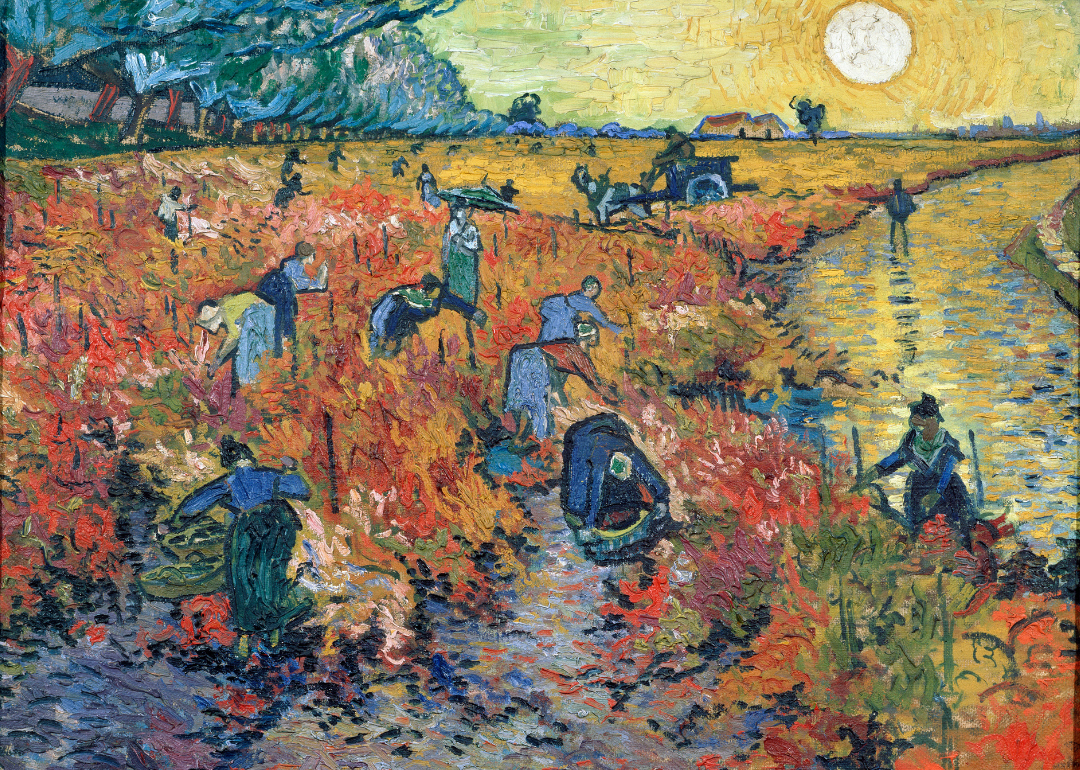
Unknown number of Van Gogh's paintings sold in his lifetime
It's a common rumor often taken as fact that Vincent Van Gogh only sold one painting during his lifetime. This rumor seems to only add to the tragic, tortured artist narrative. While Van Gogh did not see monetary success during his career, he did often barter and trade his paintings for art supplies or food. He also received a commission from his uncle, Cornelis Marinus van Gogh, for 19 cityscapes of The Hague . The first painting Van Gogh sold was to Julien Tanguy, a Parisian art dealer, and his brother Theo sold another of his works to a London gallery. His most famous sale is " The Red Vineyard " (1888), purchased by Anna Boch, the sister of Van Gogh's friend Eugène Boch. While historically there is no accurate number of what paintings were sold, it was surely more than a couple .
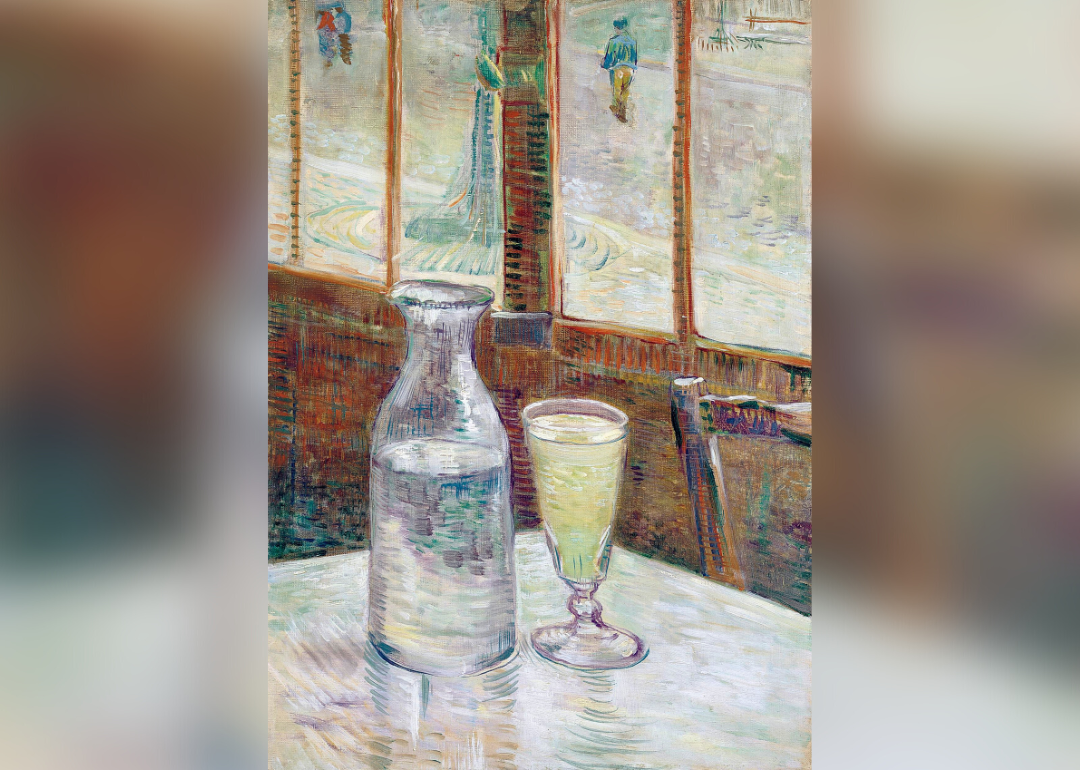
Excessively drank absinthe and used other toxins
Van Gogh's letters indicate that he drank absinthe —a strong liqueur flavored with wormwood and herbs known to cause hallucinations—heavily in the later years of his life. Wormwood contains a terpene called thujone, known to cause stomach problems, convulsions, permanent brain damage, and even death. When exposed to nicotine, it can have more powerful effects, and Van Gogh was an admitted heavy smoker.
Van Gogh was also known to use camphor to combat insomnia, and before being admitted to an asylum, he was restrained from drinking turpentine. Biochemist Wilfred Niels Arnold hypothesizes that Van Gogh may have had a strong affinity for terpenes and developed an addiction to these chemicals.
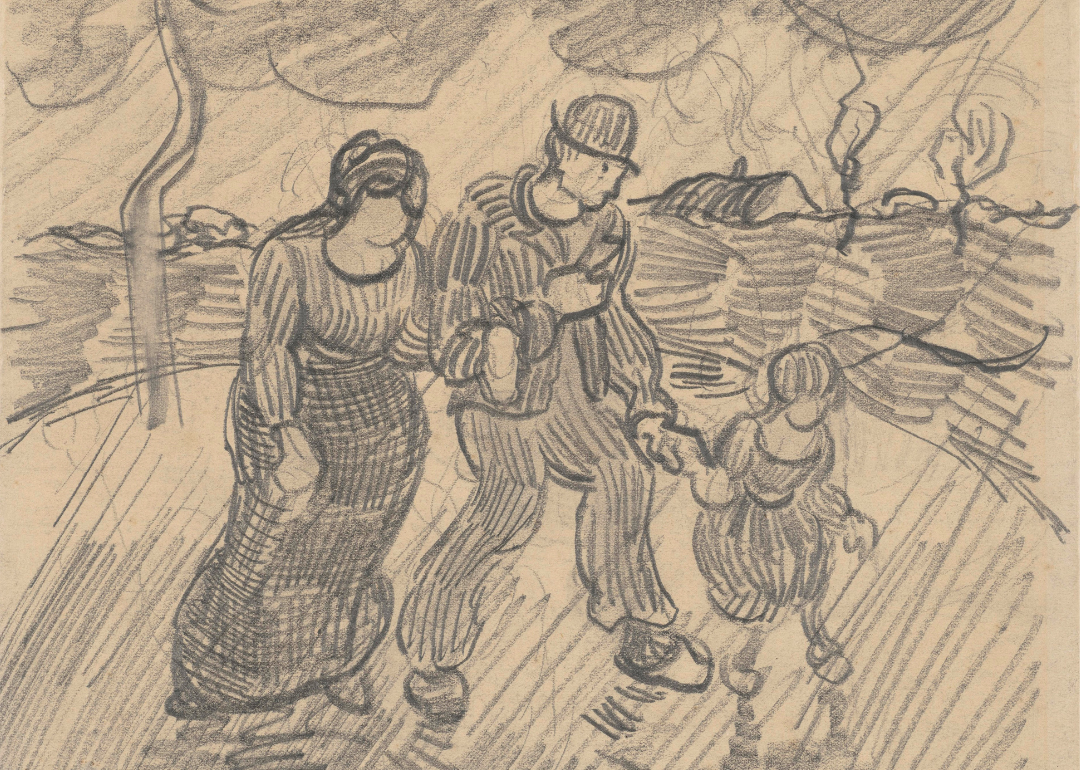
Plagued by unrequited love throughout his life
Van Gogh experienced a love life full of rejection and eventually accepted his fate at 35—as a solitary man after repeated heartbreak. He notably proposed to three women in his lifetime: Caroline Haanebeek, in 1872; Eugénie Loyer, in 1873; and his cousin Kee Vos-Stricker, in 1881. All of them rejected his proposals.
In 1884, at 31, he fell for Margot, a neighbor's daughter. The marriage was not to be, as Margot's family rejected the idea of it. Their love affair ended after Margot poisoned herself, as she experienced mood swings and nervousness, and was affected by gossip around town about the affair. Though she survived, the relationship did not last.
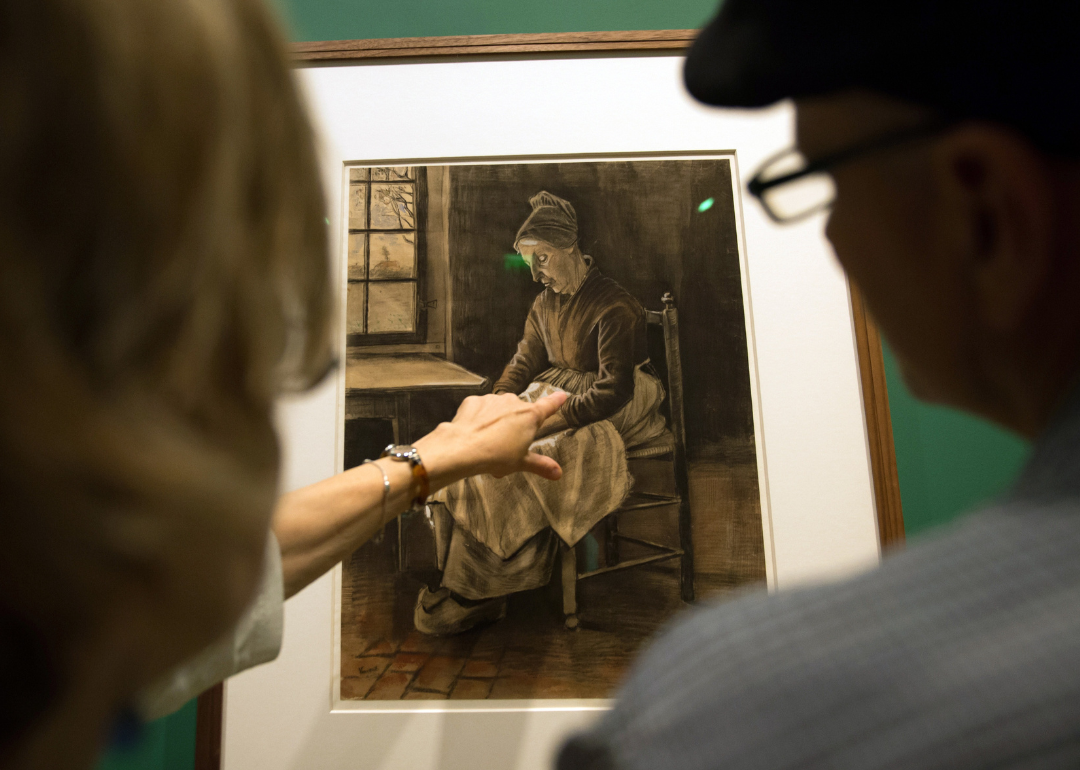
Infamous love interest and relationship
Perhaps Van Gogh's most famous lover was Clasina Maria Hoornik, better known as Sien. One of the sex workers that the artist often hired as models for his work, Sien was a single mother when she met Van Gogh in 1882, when he was 29.
He invited the pregnant Sien and her young daughter to live with him in his studio. Sien gave birth while with Van Gogh and named her newborn son Willem, although he was not the father. The relationship fell apart 18 months later due to financial woes, the intense disapproval of the relationship from Van Gogh's family, and the fact that Sien turned to sex work to support herself financially. Van Gogh then abandoned Sien and her children, moving to Drenthe, Netherlands, although he had become attached to the children, especially Willem.
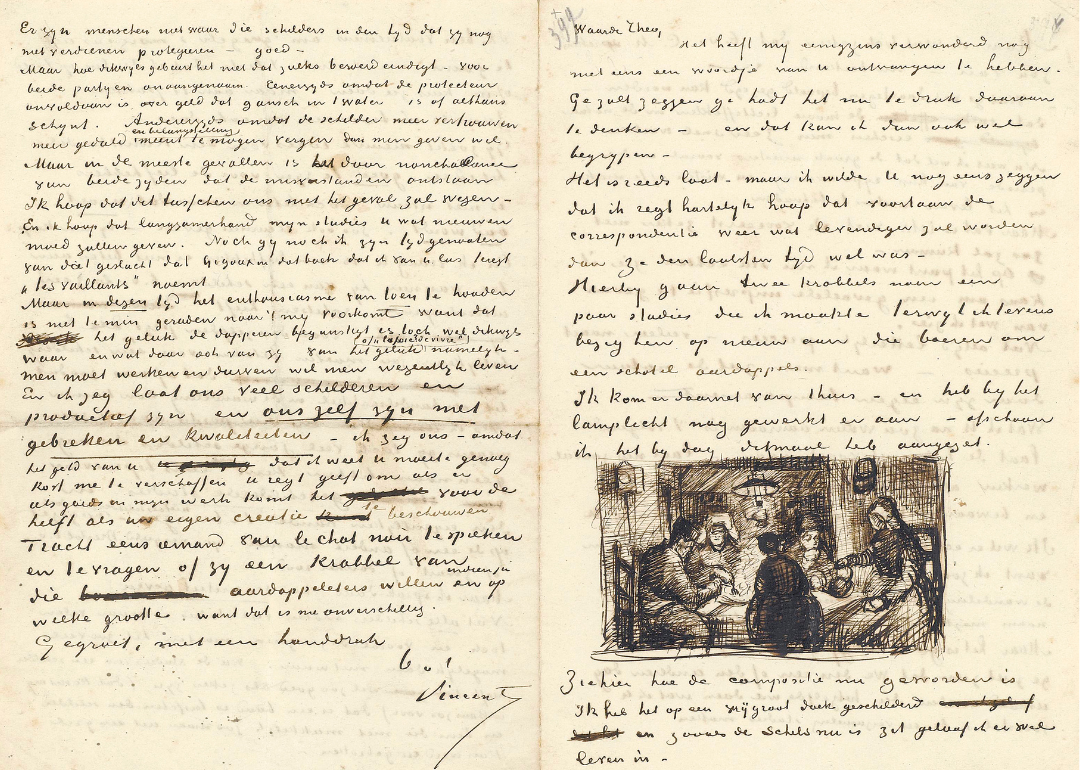
Biggest supporter was younger brother, Theo
Theodorus "Theo" van Gogh was a loyal friend to his older brother, Vincent, throughout their lives, with the nearly 700 surviving letters between them illustrating Theo's role as a confidante. As a prominent art dealer who popularized the avant-garde, impressionism, and post-impressionism art movements, many attribute Vincent's fame to Theo.
He supported Vincent financially throughout the years and encouraged and supported his artistic practice. Vincent sent Theo numerous works after he had created a collection of 150 paintings while in a mental asylum, and Theo secured 16 of his works exhibition spots, which were well-received and began to gain traction before Vincent's death.
After his brother's death in 1890, Theo's health declined rapidly; he died just six months later, in January 1891.
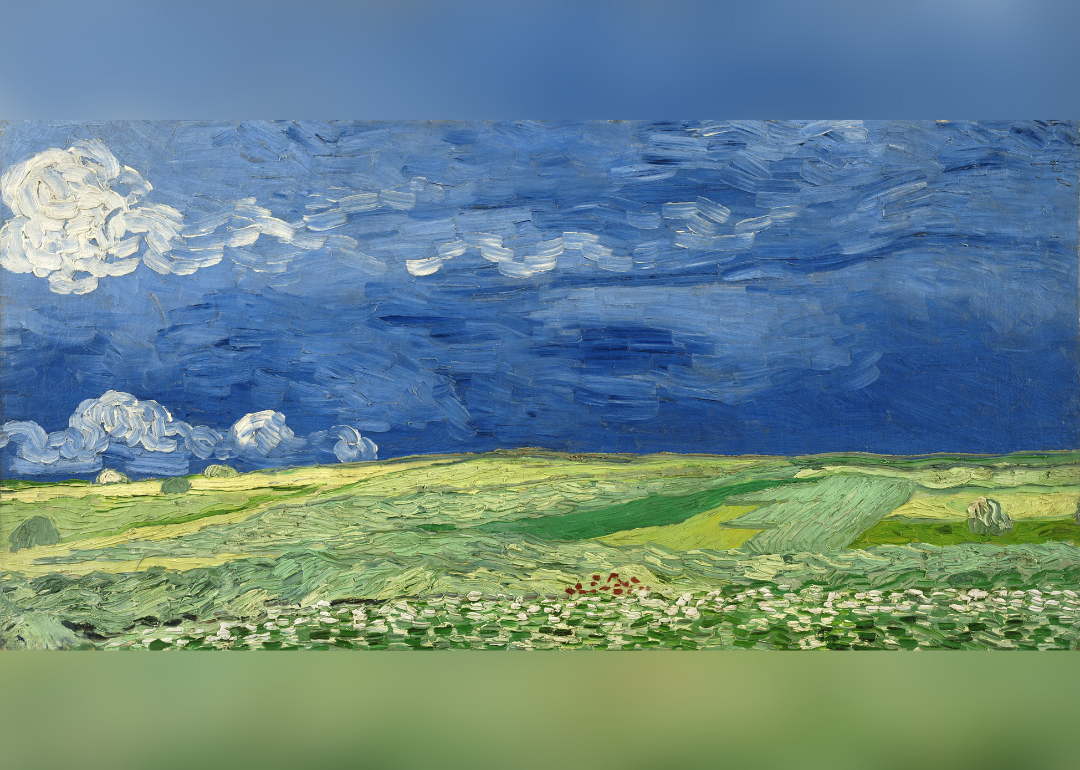
Speculation around Van Gogh's suicide
Van Gogh's life came to an end on July 29, 1890, from a gunshot wound to his belly. Art historians have widely accepted that Van Gogh died by suicide, but a 2011 book by Pulitzer Prize-winning biographers Steven Naifeh and Gregory White Smith claim the artist was murdered.
Their research stipulates René Secrétan accidentally killed the painter, as Secrétan confessed that his gang of friends would drunkenly bully the artist and brandish a pistol outside the Ravoux Inn, where Van Gogh resided in Auvers-sur-Oise, France. The authors have woven a century-old yarn that a stray bullet hit Van Gogh while he was in the fields of Auvers—with no solid proof and forensic data, however. There is not enough evidence to formally state this as a plausible theory; there is only speculation.

Van Gogh's legacy
Vincent van Gogh's legacy has made his paintings eternal. His signature brushstrokes and intentional use of color continue to move viewers. After the death of Theo, one of Vincent's younger brothers, Theo's widow, Jo van Gogh, inherited both her husband's and Vincent's art collections , where she raised awareness around Vincent's work, prompting buyers and curators to take notice.
Vincent Willem, Theo and Jo van Gogh's son, inherited the collection when his mother died and eventually transferred Van Gogh's works to the Vincent van Gogh Foundation so fans of his uncle's work could enjoy them in a museum. The Van Gogh Museum opened in Amsterdam in 1973 and is visited by 2 million people yearly. Van Gogh will never know of his posthumous legacy, of all the hearts he has touched or the eyes he has wetted, but he can be thanked for all of the beauty he created during a life, which was cut short too soon.
This story originally appeared on Masterworks and was produced and distributed in partnership with Stacker Studio.
More for You
Stephen Hawking once gave a simple answer as to whether there was a God
Forget the 4% Rule: Here's What You Should Really Be Looking At During Retirement
Judge's Instructions 'Require' Jury Find Trump Guilty, His Ex-Lawyer Says
Hollywood crews in 'crisis': 'Everyone's just in panic mode' as jobs decline
Here's What Happens If You Never Change Your Transmission Fluid
17 Unusual Mormon Rules You Won’t Believe Are Real
Man raises concerns over growing phenomenon happening with cars across the world: 'A heartbreaking collective failure'
Don't Crush Your Metal Cans When You Recycle Them. Here's Why
Suze Orman says 'no decision is bigger' in retirement than this Social Security move — here's what she wants Americans to do
This Is What a TSA Agent First Notices About You
Bronny James Goes Viral After Declining Eight NBA Workouts
“All you focus on is the white people”: Star Wars Fans Have Come Out to Defend George Lucas Against Racist Allegations That Make No Sense
The Biggest Imitation Crab Myth You Need To Stop Believing
Donald Trump Sells Private Jet Amid Spiraling Legal Costs
It’s Official: ‘Furiosa’ Is a Box Office Flameout
Americans are finally catching on to Costco's tricks — here are 15 to watch out for so you don't get fleeced on your next trip
Isaiah Thomas Was Held At Gunpoint With AK47 But Only Survived Because He Was Recognized From The NBA
Alan Hale Jr: 16 Facts About the Skipper from 'Gilligan's Island'
New ‘Protected Intersection’ Design Looks Awful, But Actually Makes Sense
Jesse Eisenberg Applied for Polish Citizenship Since He and Wife Want a 'Greater Connection to Poland'
- Make a Gift
- Directories
Search form
You are here.
- News Archive
Faculty searches complete
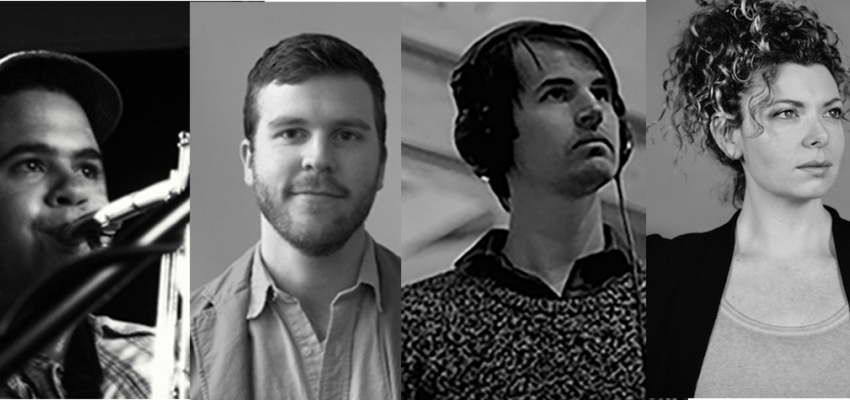
The School of Music recently announced the successful completion of faculty searches in the areas of Music Education; Composition/Improvisation/Theory; and Music Technology, plus a spousal hire in Music. New appointments are effective in Fall 2024 and Winter 2025.
Francisco Luis Reyes Peguero, Music Education
The UW gains a new assistant professor of Music Education in Fall 2024 with the recent selection of Francisco Luis Reyes Peguero to join the Music Education faculty at the School of Music.
A Latin Grammy nominated saxophonist, music educator, and researcher, Dr. Peguero holds a Ph.D. in Music Education from McGill University, an M.A. in Music Education from the Universidad de Granada, and a B.Mus in Jazz and Caribbean Music from the Conservatorio de Música de Puerto Rico.
His research interests include sociology of education, postcolonial education, and teacher education and traditional music in music education. He has published his work in the Canadian Music Educator and Research Studies in Music Education. He has also been invited to share his research in conferences in Canada, Finland, Italy, Mexico, Sweden, United Kingdom, and United States.
William Dougherty, Composition/Improvisation/Theory
Composer and sound artist William (Bill) Dougherty joins the School of Music faculty in Winter Quarter 2025 as assistant professor of Composition/Improvisation/Theory. Currently a faculty member at Temple University, Dougherty earned his DMA at Columbia University in New York City. His works have been performed internationally by ensembles including BBC Scottish Symphony Orchestra (Glasgow), The Sun Ra Arkestra (Philadelphia),Yarn/Wire (New York), Ensemble Phoenix; JACK Quartet (New York), and Talea Ensemble (New York). He is the recipient of many top composing awards and prizes, including the Luciano Berio Rome Prize in Music Composition (2021) as well as honors and fellowships from Civitella Ranieri Foundation, the American Academy of Arts and Letters, Gaudeamus Muziekweek, the Internationale Gesellschaft für Neue Musik (IGNM/ISCM), and the Aaron Copland House, among others.
Dougherty has served in a wide range of musical capacities outside of the world of art music, playing piano for early childhood music classes at the Little London Music School , serving as the Principal Organist and Choir Director of St. Mary Magdalen's Church in England, and writing and performing original music for a children's puppet show at the Philadelphia Fringe Festival . As Founder and Director of the Philadelphia Community Orchestra , Dougherty leads an instrumental ensemble—open to all ages and skill levels—that focuses on experimental, improvised, and alternative music-making in Center City, Philadelphia.
Andrew Munsey, Music and Technology
Andrew B. Munsey will initially join the Jazz Studies faculty in Fall 2024 as an assistant professor, tasked with leading the School’s fledgling Music and Technology program. A drummer, composer, and GRAMMY-nominated recording engineer, Munsey has performed and premiered works throughout North America and Europe. His collaborative works as a sound designer and composer have been exhibited and screened at the Guggenheim Museum, Centre Pompidou (FR), Documenta (DE), Van Gogh Museum (NL), Anthology Film Archives, and the Library of Congress, with festivals including the International Film Festival Rotterdam, BFI London, the Sundance and Toronto Film Festivals. His work as a sound mixer for television can be heard on PBS, Discovery International, Smithsonian, Comedy Central, and Spike TV networks.
Stephanie Richards, Music
Stephanie Richards joins the UW faculty in Fall 2024 as a Professor of Music, an appointment made possible through a spousal hire agreement between the UW and her spouse, Andrew Munsey. Richards is a trumpet player, improviser and composer, as well as a bandleader, curator, producer, and conductor. She has performed commissioned pieces and her own compositions at legendary venues like Lincoln Center, Carnegie Hall, and the Blue Note. She has collaborated with artists such as improvisational pioneers Henry Threadgill, Butch Morris, John Zorn, and Anthony Braxton, composer Helmut Lachenmann, and performance artists Mike Kelly and Yoko Ono. As a founding member of Asphalt Orchestra, created by the new music collective Bang on a Can, Richards has worked with David Byrne, St. Vincent, Susan Marshall, and Tyondai Braxton, among others, and performed alongside Kronos Quartet, The Pixies and hip hop artists Kanye West, A-Trak and Common. Championing new music for brass, she has premiered works from stages such as Lincoln Center, Carnegie Hall, Walt Disney Concert Hall, the Barbican, the Blue Note NYC, the Guggenheim Museum and others. Richards also has interests in multidisciplinary activities that have led her to collaborations with artistic areas outside music, such as dance. She holds degrees from the Eastman School of Music, McGill University, and California Institute of the Arts, and has held residency at Stanford University.
“We are thrilled to welcome Francisco Luis Reyes Peguero, William Dougherty, Andrew Munsey, and Stephanie Richards to our faculty,” says acting director Joël-François Durand. “Their areas of research and approaches to teaching and performance are well-aligned with the values and priorities we had hoped to foster with these faculty searches. We anticipate they will enhance in many positive ways the relationships between our programs in the School of Music.”
- Community Impact
- Faculty and Staff
- Program Innovation
Pokémon x Van Gogh Museum
In 2023, the Van Gogh Museum celebrated its 50th anniversary. To mark this milestone, Pokémon and the Van Gogh Museum launched an official collaboration aimed at introducing new audiences to the work of Vincent van Gogh.
On 27 September 2023 the official launch event took place in the museum with members of the press, influencers, and museum staff. From 28 September 2023 until 7 January 2024 children could enjoy various Pokémon themed activities at the museum.
The partnership was based on the shared link with Japanese art and culture: Pokémon is a Japanese pop culture icon, and Japanese prints were a significant source of inspiration for Vincent van Gogh.
The Pokémon themed activities included:
Pokémon paintings on view
Artists Naoyo Kimura (1960), sowsow (1988) and Tomokazu Komiya (1973) made Pokémon paintings inspired by famous works by Vincent van Gogh, such as Pikachu inspired by Self-Portrait with Grey Felt Hat , Munchlax & Snorlax inspired by The Bedroom , and Sunflora inspired by Sunflowers .
Pokémon Adventure & Drawing Pikachu
Children aged six and above could participate in the Pokémon Adventure at the museum, which introduced them to the Pokémon paintings and the stories behind Vincent van Gogh’s masterpieces.
Furthermore, a guided video activity was available in the museum that taught young visitors how to draw fan favourite Pokémon Pikachu, and encouraged them to try this for themselves.

Pokémon Adventure treasure hunt along the Pokémon paintings
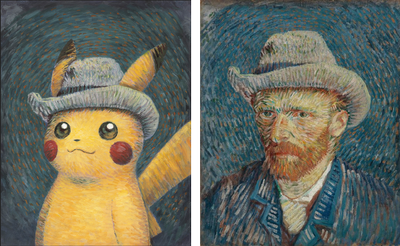
Left: Pikachu inspired by ‘Self-Portrait with Grey Felt Hat’, Naoyo Kimura (1960), The Pokémon Company International, ©2023 Pokémon / Nintendo / Creatures / GAME FREAK. Right: Vincent van Gogh, ‘Self-Portrait with Grey Felt Hat’, 1887, Van Gogh Museum Amsterdam (Vincent van Gogh Foundation).
Teaching material
An (online) lesson exploring the relationship between Van Gogh and Japanese artists was developed for primary and secondary schoolchildren. Vincent van Gogh was a great admirer of Japanese prints. He liked the large areas of strong colours, the everyday subjects, and the focus on details from nature.
The teaching material is available in Dutch and English in the lessons overview at the educational platform Van Gogh at School until the end of 2026.
Exclusive merchandise
As part of this partnership, a special Pokémon promo card, and an exclusive range of Pokémon x Van Gogh Museum products was developed. The merchandise was available in the Van Gogh Museum shop and webstore, and via The Pokémon Centre.

A selection of exclusive Pokémon x Van Gogh Museum merchandise

IMAGES
COMMENTS
Vincent van Gogh (born March 30, 1853, Zundert, Netherlands—died July 29, 1890, Auvers-sur-Oise, near Paris, France) was a Dutch painter, generally considered the greatest after Rembrandt van Rijn, and one of the greatest of the Post-Impressionists.The striking color, emphatic brushwork, and contoured forms of his work powerfully influenced the current of Expressionism in modern art.
By the outbreak of World War I, with the discovery of his genius by the Fauves and German Expressionists, Vincent van Gogh had already come to be regarded as a vanguard figure in the history of modern art. ... Libraries and Research Centers Shop Search; Go. Heilbrunn Timeline of Art History Essays Vincent van Gogh (1853-1890) ...
Vincent Willem van Gogh (Dutch: [ˈvɪnsɛnt ˈʋɪləɱ‿vɑŋ‿ˈɣɔx] ⓘ; 30 March 1853 - 29 July 1890) was a Dutch Post-Impressionist painter who is among the most famous and influential figures in the history of Western art. In just over a decade, he created approximately 2100 artworks, including around 860 oil paintings, most of them in the last two years of his life.
Some of van Gogh's most famous works include "Starry Night," "Irises," and "Sunflowers." In a moment of instability, Vincent Van Gogh cut off his ear and offered it to a prostitute. Van Gogh died ...
Vincent Van Gogh was born the second of six children into a religious Dutch Reformed Church family in the south of the Netherlands. His father, Theodorus Van Gogh, was a clergyman and his mother, Anna Cornelia Carbentus, was the daughter of a bookseller. Van Gogh exhibited unstable moods during his childhood, and showed no early inclination ...
Vincent van Gogh (1853-1890) was a Dutch post-impressionist artist whose paintings are amongst the most popular and recognizable in history. His dramatic brushwork, exuberant palette, and mastery at capturing moments in time and light revolutionised art. Only recognised at the end of his life, his struggles and triumphs have coloured exactly ...
The Van Gogh Museum conducts research on the life and work of Vincent van Gogh and the art of his time. Find out more about the research projects and how we share the results. Senior Researcher Teio Meedendorp tells the story of a lesser-known painting by Vincent van Gogh: Pollard Birch. For years ...
Van Gogh was born in Holland, the son of a pastor; he travelled to London in 1873, and first visited Paris in 1874. Over the next decade he was employed in various ways, including as a lay preacher. By 1883 he had started painting, and in 1885-6 he attended the academy in Antwerp where he was impressed by Japanese prints and by the work of Rubens.
Biographies. Will Atkinson is Reader in the School of Sociology, Politics and International Studies at the University of Bristol, UK. His recent books include Beyond Bourdieu (2016), Class in the New Millennium (2017) and Bourdieu and After (2020). Vincent van Gogh is one of the most well-known and influential artists in the western tradition.
Project. In the initial phase (November 2017-November 2020), the project focuses on all the works by Vincent van Gogh in the Netherlands: over 300 paintings and around 900 works on paper. After that, works from the rest of the world will also be added to the platform. For example, works from the collections of The Art Institute in Chicago and ...
Van Gogh became an artist in 1881. Although he studied briefly in Antwerp and Paris, he was largely self-taught. He ultimately chose to live in the country, and most of his paintings capture his deep affinity for nature. Theo, an art dealer, introduced Vincent to Paris's most advanced painters, and his work changed under the influences of Edgar ...
Generally overshadowed by the fame and familiarity of his paintings, Vincent van Gogh's more than 1,100 drawings remain comparatively unknown, although they are among his most ingenious and striking creations. Van Gogh engaged drawing and painting in a rich dialogue, which enabled him to fully realize the creative potential of both means of expression.
The essays and entries feature the most current research on Van Gogh's drawings and provide fresh interpretations of the motivating influences that shaped the artist's contributions to the history of drawing. Vincent van Gogh (Dutch, 1853-1890) believed that drawing was "the root of everything." A self-taught artist, he succeeded, between ...
Vincent van Gogh (1853-1890) did not decide to become an artist until he was 27 years old. When he walked into a wheat field and shot himself in the chest 10 years later, on July 27, 1890, he triggered an enduring archetype of the mentally unstable artist. But he was neither alone nor unloved. His younger brother, Theo, provided emotional and financial support and they corresponded frequently.
Vincent van Gogh was 35 years old when he cut off his left ear just before Christmas, 1888. It was the beginning of a period of uncertainty. Several severe crises and attacks followed, but it remained unclear what exactly Vincent was suffering from. Yet, it had a serious impact on his life. Vincent ...
The Starry Night, a moderately abstract landscape painting (1889) of an expressive night sky over a small hillside village, one of Dutch artist Vincent van Gogh's most celebrated works.. Description. The oil-on-canvas painting is dominated by a night sky roiling with chromatic blue swirls, a glowing yellow crescent moon, and stars rendered as radiating orbs.
Van Gogh was a troubled soul and master painter who relied on his emotions and color to create art that continues to attract millions of viewers. The icon indicates free access to the linked research on JSTOR. With the advent of digitization, art has become more accessible to the masses than ever before. While the world of NFTs and crypto art ...
Self-portraits by Vincent van Gogh in museum collections around the world. Vincent van Gogh, Self-Portrait Dedicated to Paul Gauguin, 1888. Harvard Art Museums/Fogg Museum, Bequest from the Collection of Maurice Wertheim, Class of 1906, 1951.65. oil on canvas 61.5 x 50.3 cm (24 3/16 x 19 13/16 in.)
In his self-. portraits van Gogh would explore his sense of self and the methods of self-representation. By. using himself as a sitter he became familiar with his features and explored his sense of self. Like. his other works he incorporated his emotional response to the subject through his palette and use.
Colour degradation. 'Paintings fade like flowers', Vincent van Gogh once wrote, and it is true that the appearance of many of his paintings and drawings has altered significantly due to colour degradation. The innovative REVIGO project (REassessing VIncent van GOgh) is dedicated to researching the colours Van Gogh used and how they have ...
Self-Portrait or Portrait of Theo van Gogh by Vincent van Gogh, 1887 Source: Van Gogh Museum, Amsterdam Another portrait painted in mid-1887 was long thought to be a self-portrait. In 2011, research into the painting concluded that it was actually a portrait of Vincent's younger brother Theo. However, more recently that theory has been ...
Libraries and Research Centers ... Vincent van Gogh (Dutch, Zundert 1853-1890 Auvers-sur-Oise) mid-July, 1883. European Paintings at The Met The Met's celebrated European Paintings collection encompasses more than 2,500 works of art from the thirteenth through the early twentieth century. ...
A portrait of Vincent Van Gogh at Monastery Saint-Paul de Mausole created by the hospital's chief psychiatrist, Jean-Marc Boulon. Photo: Adam Schrader. "They have their own reasons for putting ...
The Van Gogh Museum is currently conducting further research into the sub-collections and improving access to them. An important part of this research involves reconstructing and publishing the provenance of these works. Vincent and Theo van Gogh laid the foundations for the Contemporaries collection.
The life and works of Vincent van Gogh have enamored lovers of fine art since the late 20th century, many years after his tragic death in 1890.His work in expressionism greatly influenced modern ...
The Van Gogh Museum conducts research on Vincent van Gogh and the art of his time. Collection Catalogues Van Gogh's Paintings and Drawings The final collection catalogue focuses on Van Gogh's paintings 1888-1890, and is scheduled for 2023. Read more Collection Catalogue ...
His collaborative works as a sound designer and composer have been exhibited and screened at the Guggenheim Museum, Centre Pompidou (FR), Documenta (DE), Van Gogh Museum (NL), Anthology Film Archives, and the Library of Congress, with festivals including the International Film Festival Rotterdam, BFI London, the Sundance and Toronto Film Festivals.
To mark this milestone, Pokémon and the Van Gogh Museum launched an official collaboration aimed at introducing new audiences to the work of Vincent van Gogh. On 27 September 2023 the official launch event took place in the museum with members of the press, influencers, and museum staff. From 28 September 2023 until 7 January 2024 children ...